Chapter 2 Levels Of Organization Of Life Very Short Answer Questions
Question 1. Name two prokaryotic cells.
Answer: Bacteria and Blue-green algae.
Question 2. Name two trace elements of protoplasm.
Answer: Iron and Manganese.
Question 3. Name two types of essential secretory products of protoplasm.
Answer: Zymogen and. Hormones.
Read and Learn more about WBBSE Solutions for Class 10 Life Science And Environment
Question 4. Name two components of bacterial cell walls which are not present in the cell walls of higher plants.
Answer: Mucopeptide and Peptidoglycan.

Question 5. State the function of the centriole.
Answer:
(1) originate cilia and flagella.
(2) formation of a spindle during cell division.
Question 6. Where are the chlorophyll molecules concentrated in the chloroplast?
Answer: Quantasomes present in thylakoids.
Question 7. Name one single-layered membrane organelle in the cell.
Answer: Golgi body and Lysosome.
Question 8. What is a tonoplast?
Answer: Outer covering of central vacuole of a mature plant cell.
Question 9. Name one plant cell and one animal cell where the nucleus is absent.
Answer: Plant cell — Sieve tube, Animal cell — matured mammalian RBC.
Question 10. What is the function of dictyosome?
Answer: It is the Golgi body of plant cells and helps.in secretory process.
Question 11. Which organelle connects the cell membrane with the nuclear membrane?
Answer: Endoplasmic reticulum.
Question 12. Name the plant cell visible to the naked eye.
Answer: Root hair cell, fibre cell of jute.
Question 13. What is plasmodesmata ?
Answer: Cytoplasmic bridges between adjacent plant cells. They help to maintain the continuity of cytoplasm between two adjacent cells.
Question 14. What is glycocalyx?
Answer: It is an external covering present around the plasma membrane of some animal cells, made up of glycoprotein. :
Question 15. What is cytosol?
Answer: Cytoplasmic matrix.
Wbbse Class 10 Life Science Solutions
Question 16. Name a cell where mitochondria are present in large numbers.
Answer: Liver cells, cardiac muscle cells.
Question 17. Name two animal cells containing more than one nuclei.
Answer: Skeletal muscle cells and Paramecium.
Question 18. What is cell sap?
Answer: Cell sap is the fluid present within the vacuole, containing water, salt and enzymes.
Question 19. Name the membrane on which epithelial tissue rests.
Answer: Basement membrane.
Question 20. Name the tissue which lacks blood vessels.
Answer: Epithelial tissue.
Question 21. Give the name of one inflammatory protein stored by mast cells.
Answer: Histamine.
Question 22. Which tissue synthesises, stores and metabolises fat?
Answer: Adipose tissue.
Question 23. Name the tissue which connects a bone to another bone.
Answer: Ligament.
Question 24. Name the tissue where Haversian canals are found.
Answer: Bones.
Question 25. Mention the site of haemoglobin synthesis.
Answer: Red Bone marrow of long bones.
Question 26. Which pigment is formed when haemoglobin is catabolised?
Answer: Bilirubin.
Wbbse Class 10 Life Science Solutions
Question 27. What is polycythemia?
Answer: Abnormal increase in the number of RBCs.
Question 28. Name the type of epithelium that bears microvilli for absorption.
Answer: Brush-bordered cuboidal epithelium.
Question 29. Name two fluids found in the body.
Answer: Blood and lymph.
Question 30. Name the tissue which fills the gap between the organiser:
Answer: Connective tissue.
Question 31. Name the type of epithelium that lines the inner surface of the stomach.
Answer: Simple columnar epithelium.
Question 32. What are Kupffer cells?
Answer: The phagocytic cell is found in the liver.
Question 33. What is Rigor mortis?
Answer: Muscles become rigid after death.
Question 34. What are tendons?
Answer: A band of collagen fibres which joins the skeletal muscle to the bone.
Question 35. Which type of food fulfils the requirement of nitrogen in the animal body?
Answer: Protein
Wbbse Class 10 Life Science Solutions
Question 36. Name the disease which is caused by the deficiency of vitamin A.
Answer: Xerophthalmia.
Question 37. Name a vitamin that is dissolved in a fatty substance or fat.
Answer: Vitamin A.
Question 38. Name a vitamin which is solubilized in water.
Answer: Vitamin B.
Question 39. Deficiency of which vitamin causes an interruption in. blood coagulation?
Answer: Vitamin K.
Question 40. Deficiency of which vitamin causes rickets?
Answer: Vitamin D.
Question 41. Which vitamin is obtained from sour fruits? Give deficiency symptoms of this vitamin.
Answer: Vitamin C. Its deficiency causes Scurvy.
Question 42, What is a nucleotide?
Answer: Nucleotide is the structural unit of nucleic acid (DNA and RNA). Deoxyribonucleotide is the structural unit of DNA and ribonucleotide is the structural unit of RNA.
Question 43. Mention the main two types of tissue.
Answer: Two types of plant tissue are meristematic tissue and plant tissue.
Question 44. Name the tissue which is present at the apex of the stem.
Answer: Meristematic tissue.
Question 45. Name any two types of simple tissue.
Answer: Parenclyma and collenchyma are two types of simple permanent tissue.
Question 46. Name the parenchyma tissue containing air.
Answer: Aerenchyma cells contain air cavities.
Question 47. Name the parenchyma tissue containing chlorophyll.
Answer: Chlorenchyma cells contain chlorophyll.
Question 48. Name the simple tissue whose corners are thickened without intercellular spaces.
Answer: In Collenchyma corners are thickened without intercellular spaces.
Wbbse Class 10 Life Science Solutions
Question 49. Name the dead simple permanent tissue.
Answer: Schlerenchyma is the dead simple permanent tissue.
Question 50. Name the largest organ of the human body.
Answer: The skin is the largest organ of the human body.
Question 51. Name the acid present in the stomach.
Answer: Hydrochloric acid.
Question 52. Where is the pancreas located?
Answer:
Function :
(i) Processes all sensory information and generates responses accordingly.
(ii) Act as the centre for memory, intelligence, thinking and all other mental activities.
Question 53. Mention one function of the liver.
Answer: It synthesizes bile, stores glycogen, and helps in detoxification.
Chapter 2 Levels Of Organization Of Life Short Type Questions And Answers
Question 1. Name the type of enzyme present in mitochondria and lysosomes.
Answer:
In Mitochondria — Oxidative enzymes
In Lysosomes — Hydrolytic enzymes
Question 2. Define cell.
Answer:
Cell:
The term cell was first used by Robert Hooke (1665). The cell is the structural and functional unit of all living organisms.
The branch of biology which deals with the study of the structure of cells is called cytology.
Question 3. Name the smallest and the largest plant cell and animal cell.
Answer:
Smallest cell — Mycoplasma gallisepticum
Longest plant cell — Phloem fibre of Ramie plant
Longest animal cell — Mammalian Neurone.
Question 4. Differentiate between organ and organelle.
Answer:
Organs are structural components of multicellular plant and animal bodies. They are macroscopic structures.
Organelle are structural components of a cell and are microscopic.
Question 5. What is cell theory?
Answer:
Cell theory:
Cell theory was proposed by Schleiden and Schwann (1839).
(1) All organisms—animal or plants—consist of cell
(2) Cells are of universal occurrence and are the basic unit of an organism.
(3) All cells are produced from the pre-existing cells.
Cell shape and size :
The shape of the cell differs in different organisms. It may be round, cylindrical, cuboid, columnar or thread-like. The cells are mostly microscopic. The smallest cell is a pleuropneumonia-like organism (PPLO). The largest cell is the egg of the ostrich. In mammals, the nerve and muscle cells may reach up to 900 mm in length.
Question 6. What are the exceptions to cell theory?
Answer:
(1) Viruses without cellular organisation
(2) Prokaryotes without true cellular structure
(3) Mucor, Rhizopus and Vaucharia do not conform to the normal definition of cell.
Wbbse 10th Class Life Science Question Answer
Question 7. Classify animal tissue.
Answer:
Depending on the structure and function, the animal tissue is classified into 4
types :
1. Epithelial tissue
2. Connective tissue
3. Muscular tissue
4. Nervous tissue.
What are essential amino acids?
Answer:
Essential amino acids :
Several nutritionally important amino acids are not synthesized inside a living body. These are to be taken with dietary proteins. Such amino acids are called essential amino acids. These are methionine, tryptophan, histidine, phenylalanine, valine, threonine, lysine, leucine, and isoleucine.
Question 8. What are polysaccharides?
Answer:
Polysaccharides :
These are large carbohydrates, composed of more than ten monosaccharide units. The basic molecular formula of polysaccharides is (C6H10O5)n. They are generally insoluble in water and not sweet to taste.
Examples: Starch, cellulose (found in plant cells), glycogen (found in animal cells), chitin (found in insect bodies), etc.
Question 9. Name two animal sources and two plant sources of fat type of food.
Answer:
Source :
1. Plant source — Mustard oil, coconut oil, groundnut oil, etc.
2. Animal source — Meat, milk and milk products like ghee, butter, cheese, etc.
What is fat or lipid?
Answer:
Fat:
Eat is the ester of fatty acid and glycerol. The salt of alcohol (glycerol) with organic acid (fatty acid) is known as ester. Lipid is a broad term which includes fat, wax, cholesterol, and hydrocarbon since all of them are insoluble in water but soluble in organic solvents.
Question 10. What is a vitamin?
Answer:
Vitamin:
Vitamins are smaller biomolecules, required in small amounts, for normal functioning of the body and provide resistance against some diseases. These act as coenzymes in several enzyme-dependent metabolic reactions.
Question 11. Name fat-soluble and water-soluble vitamins.
Answer:
(1) Fat-soluble vitamins (vitamins A, D, E, K) and
(2) Water-soluble vitamins (vitamin C and B complex).
Question 12. Which vitamin is known as an antihaemorrhagic factor?
Answer: Blood clotting — It takes part in the manufacture of prothrombin (clotting protein factor of blood in plasma) in the liver and helps in normal blood coagulation.
Wbbse 10th Class Life Science Question Answer
Question 13. State three characteristics of meristematic tissue.
Answer:
Characteristics :
(1) Cells are living, undifferentiated, polygonal, spherical or oval in shape.
(2) Cells are densely packed with no intercellular spaces.
Question 14. Mention the functions of the xylem.
Answer:
Function :
(1) Xylem helps in transportation of water and solutes undirectionally.
(2) Acts as supportive tissue, imparting mechanical strength to the plant body.
(3)Helps in the storage of water and mineral salts.
Question 15. Mention the functions of phloem.
Answer:
Functions :
(1) Conduction of food — by sieve tubes of phloem both in upward and downward directions.
(2) Storage of organic food matters.
(3) Lateral translocation of food by the companion cells.
Question 16. State two structural features of permanent tissue.
Answer:
Characteristic features :
(1) Intercellular space may be present in between the cells.
(2) Cells may or may not contain protoplasm and, hence may be living or dead.
Question 17. State two structural features of epithelial tissue.
Answer:
Structure :
(1) Cells are present on a basement membrane made of connective tissue.
(2) Cells are densely packed & joined together by microproteins.
Question 18. State two functions of connective tissue.
Answer:
Function :
(1) Areolar tissue acts as packing material between organs
(2) Adipose tissue stores fat for future use, keeps the body warm and protects it from mechanical injury.
Question 19. State two structural features of muscular tissue.
Answer:
Structure :
(1) Cells are elongated, cylindrical or spindle-shaped.
(2) Bundles of muscle fibres, surrounded by connective tissue, constitute a muscle.
Wbbse 10th Class Life Science Question Answer
Question 20. Mention two functions of the Brain.
Answer:
Function :
(1) Processes all sensory information and generates responses accordingly.
(2) Act as the centre for memory, intelligence, thinking and all other mental activities.
Chapter 2 Levels Of Organization Of Life Descriptive Type Questions And Answers :
Question 1. What are biomolecules?
Answer:
Biomolecules
Building block molecules are called biomolecules. They make up the body of organisms, cells and cell organelles.
It is of two types —
(1) Micro-molecules :
Small molecule size with low molecular weight, eg. minerals, water, gases, carbohydrate, etc.
(2) Macro-molecules :
Large molecule size with high molecular weight. It is formed by polymerisation of many micro-molecules of one type.
eg: Protein, Polysaccharides, Nucleic acid.
Question 2. What is the average composition of plant and animal cells?
Answer:
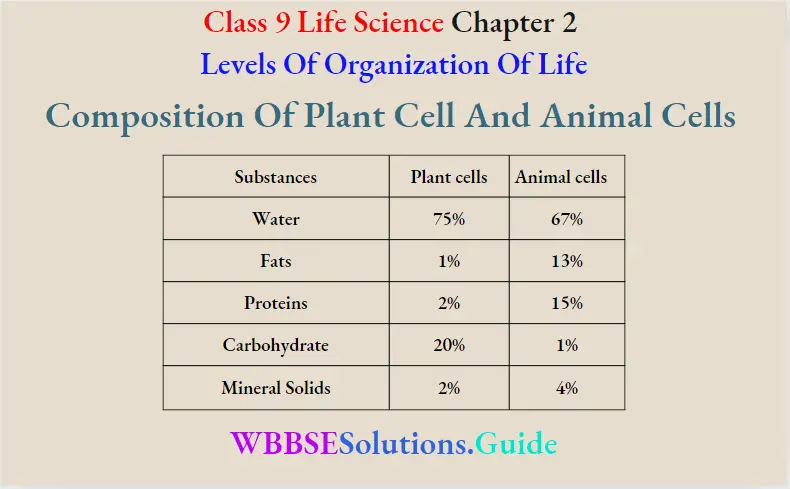
Question 3. Write the roles of inorganic compounds in the body of living organisms.
Answer:
Water :
It is the most abundant inorganic compound in living organisms. On an average, water forms 65-75% of protoplasm.
It acts as a solvent for all soluble substances in the cell. It provides an aqueous medium for various cellular reactions. It provides proper hydration to protoplasm. It provides turgidity to the cells in plants. Water maintains constant body temperature in plants and animals. Water acts as a source of hydrogen in photosynthesis.
Gases :
The main gases which play an important role in metabolism are O2 and CO2. Oxygen is needed for the aerobic breakdown of organic food and the release of energy for life. Carbon dioxide is used by photosynthetic autotrophs for the synthesis of carbohydrates.
Question 4. What are carbohydrates? Write their functions.
Answer:
Carbohydrates
Organic compounds containing carbon, hydrogen and oxygen. Its general formula is Cn(H2O)n. Based on the number of sugar Units in the molecule, it is classified as
(1) Monosaccharides :
Contain only one sugar unit known as glucose or simple sugar. These are the reducing agents.
Eg. Glucose (C6H12 O6)
(2) Oligosaccharides :
Carbohydrates with 2-9 mono-saccharides joined together.
glucose + glucose -» Maltose
glucose + fructose -» Sucrose
glucose + glucose -— Lactose~
(3) Polysaccharides :
Carbohydrate with 10 or more mono-saccharide units. These are macro-molecules.
Eg: Starch and cellulose.
Wbbse 10th Class Life Science Question Answer
Functions :
(1) These are structural components.
(2) Play an important role in metabolic functions.
(3) Act as a potential source of energy in cells.
Question 5. What are Amino Acids and proteins? Write their functions.
Answer:
Amino Acids and proteins
Amino acids are microbiomolecules with low molecular weight. They contain C, H, O and N, S.
These are essential and non-essential amino acids.
Essential amino acids are 8 in number. These are not synthesized in animal cells and obtained through diet only, eg. Valine, Leucine, Methionine, Lysine etc.
Non-essential amino acids are 10 in number and are naturally synthesized in the body.
eg. Alanine, Arginine, Aspartic acid, Serine.
Semi-essential Amino Acid :
Only 2 in number can be synthesized in animal cells but not enough. Eg. Arginine and Histidine.
Amino Acids are used in protein synthesis, glucose, vitamins and hormone synthesis.
Question 6. Write the structure and functions of the protein.
Answer:
These are long-chain polymers of amino acids with very high molecular weight. It contains C, H, O, N, S and P. The bond which joins two amino acid molecules is a peptide bond.
Types of protein :
(1) Simple protein :
made of only amino acids, eg: albumin, and histone.
(2) Conjugated protein :
made of amino acid + some non-protein group.
Example: Nucleoprotein, Glycoprotein.
(3) Derived protein :
These are intermediate degradation products of protein, obtained on the hydrolysis of protein.
Functions of Protein :
(1) These are structural constituents of protoplasm, protoplasmic organelles and cell membrane.
(2) Enzymes are proteins, essential for metabolism.
(3) Cytochrome pigment helps in photosynthesis and Respiration.
(4) Haemoglobin transports oxygen in the body.
(5) Actin and myosin help in muscle contraction.
(6) Fibrinogen and thrombin help in blood clotting.
Question 7. Write the structure and functions of lipids in the human body.
Answer:
Lipids are oily, greasy organic compounds, insoluble in water. Lipid molecule contains C, H, O. It has less percentage of oxygen.
These are :
(1) Simple lipids :
These are esters of fatty acids with alcohol.
eg. Bees wax, cholesterol.
Wbbse 10th Class Life Science Question Answer
(2) Compound lipids :
These are fatty acids + Alcohol + Some other group.
eg. Phospholipid, Glycolipid, Steroids Carotenoids.
Functions of lipids:
(1) Release more energy than carbohydrates.
(2) Constituent of cell membrane.
(3) Acts as a solvent for fat-soluble vitamins.
(4) Acts as insulator.
Question 8. What are Nucleotides and Nucleic Acids?
Answer:
Nucleotides :
Nucleotides are the building block unit for Nucleic acid. These are macromolecules with low molecular weight.
Nucleotide = Pentose Sugar + Nitrogenous base + Phosphate group.
Nucleic Acid:
These are long-chain polynucleotide macromolecules. These are the most important biomolecules and control most biological processes, including heredity.
There are two types of Nucleic acid: DNA and RNA.
DNA (Deoxyribose Nucleic Acid): Double-stranded helical structure. Two strands are antiprallel_ and coiled around each other. Complementary base pairs are :
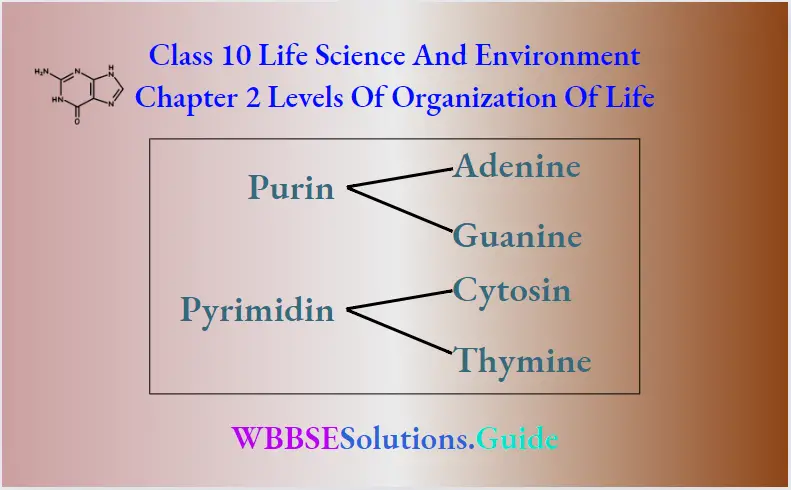
Adenine is attached to thymine with a double hydrogen bond and Guanine with cytosine with a triple hydrogen bond. DNA has the unique ability of self-replication.
Functions of DNA:
(1) It is the genetic material of all organisms (except some viruses).
(2) It takes part in genetic recombination.
(3) It can replicate itself.
RNA (Ribose Nucleic Acid) :
Single-stranded, long-chain polynucleotide. Complementary base pairs are — Adenine, Guanine, Cytosin, and Uracil. These are mainly present in cell cytoplasm.
Types :
Messenger RNA (mRNA)
Transfer RNA (tRNA)
Ribosomal RNA (rRNA)
Functions :
(1) Involved in protein synthesis.
(2) In certain viruses acts as the genetic material.
Question 9. What are vitamins? Write their roles in the human body.
Answer:
Vitamins :
Vitamins are complex organic chemicals that are present in our
food in small quantities. Vitamins are essential for growth, good health, proper vision, normal digestion process and co-ordinate activities of our body.
These are :
(1) Fat-soluble vitamins — A, D, E, K
(2) Water soluble vitamins — B complex and C
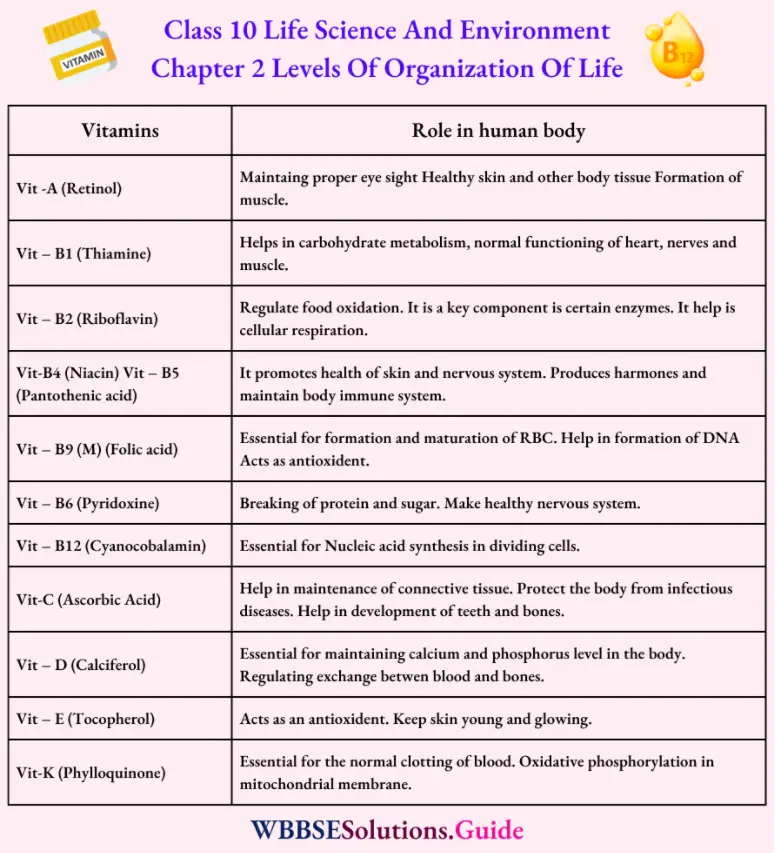
Question 10. What are minerals? Write the role of minerals in the human body.
Answer:
Minerals :
These are an inorganic element, occurring in the form of its salts. Elements which are required in larger amounts for normal nutrition are called macroelements. Eg, C, H, N, O, P, Ca.
Elements which are required in very small amounts for normal nutrition are called microelements. Eg, Iron, Copper, Zinc, Iodine.
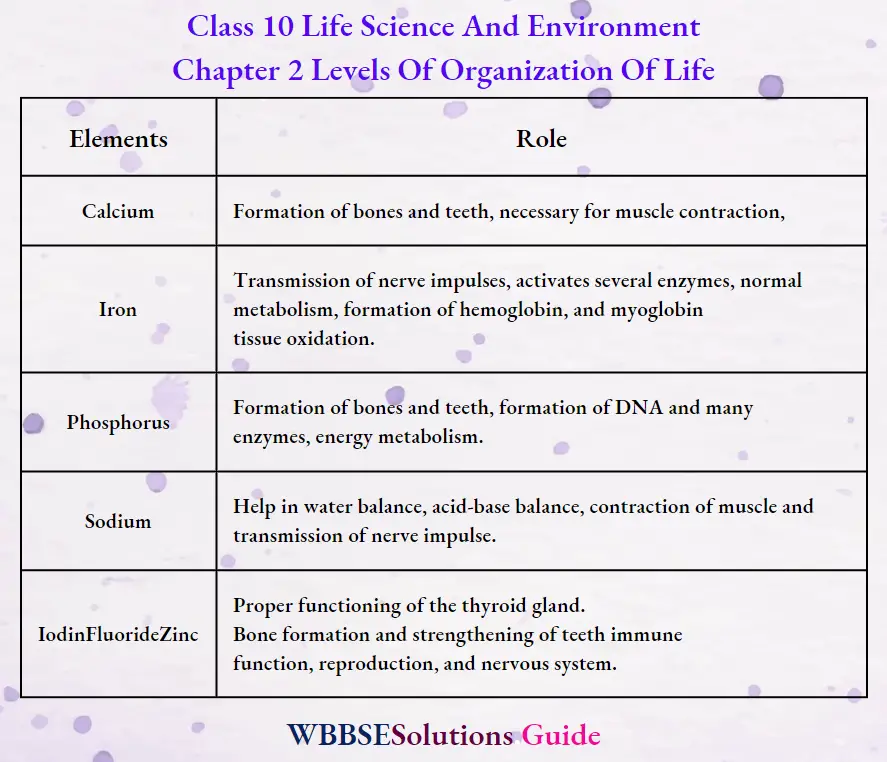
Question 11. Write the structure and function of the cell wall.
Answer:
Cell Wall :
Present in plant cells, fungi and bacteria but absent in an animal cell. It is a non-living, rigid covering, external to the plasma membrane. A cell wall differentiated into middle lamella, primary cell wall and secondary cell wall. There are minute pores on the cell wall, through which cytoplasmic continuity is established between the adjacent cells. Their cytoplasmic bridges are called Plasmodesmata. The middle layer is made up of pectin and some amount of protein. The primary cell wall is thin and permeable, composed of cellulose. The secondary cell wall is also made up of cellulose with hemicellulose, pectin and lignin.
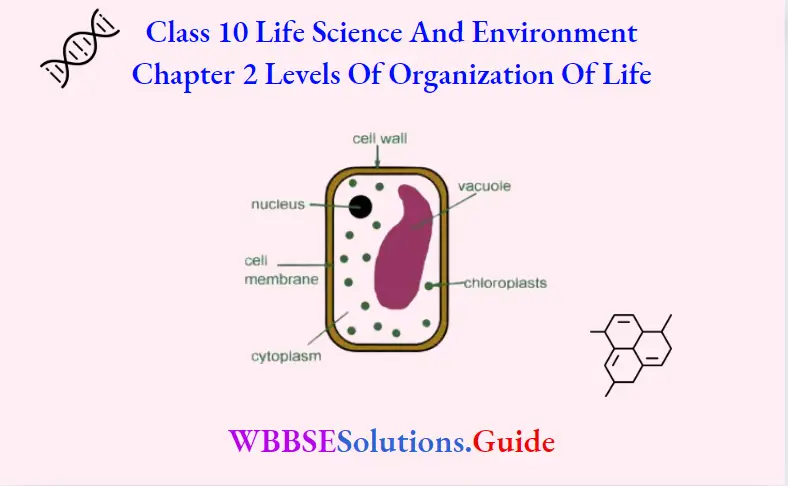
Functions:-
(1) Provides cell its shape.
(2) Protect the cell membrane and cell content.
(3) Prevents the drying of a cell
(4) Provides mechanical support to the cell
(5) Helps in the maintenance of osmotic balance.
Question 12. Write the structure and functions of the cell membrane.
Answer:
Cell membrane — (Plasma membrane)
The thin, elastic and semi-permeable living membrane that surrounds the protoplasm of a cell.
Nageli and Cramer (1856) reported about the existence of it. Plowe (1931) named it as plasmalemma.
Structure :
Singer and Nicholson (1972) showed that the membrane is formed of two phospholipid layers with distinct surface proteins and integral proteins in between. The name given is the Fluid Mosaic Model. The point of attachment of the cell membrane of two cells is known as a desmosome.
Spherical hydrophilic polar heads of lipids are directed towards the two surfaces of the membrane. The hydrophobic tails of lipids are directed inwards.
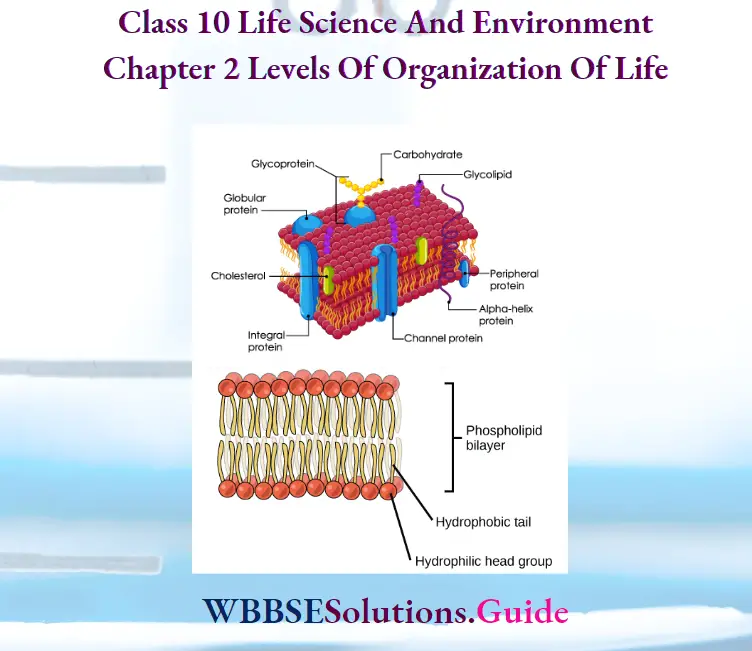
Functions :
(1) It denotes the shape of an animal cell.
(2) It protects the cytoplasm.
(3) It helps in the intercellular transport.
(4) It helps in diffusion and osmosis between cells.
(5) It helps in cell eating and cell drinking by phagocytosis and pinocytosis.
(6) Seletive permeability.
(7) Help in maintaining homoeostasis in the cell.
Question 13. What is Cytoplasm?
Answer:
Cytoplasm:
Occupies cell space in between plasma membrane and nucleus. It is a part of protoplasm. It is a jelly-like, colloidal matrix and the seat of all metabolic activities of the cell.
It consists of protein, fats, carbohydrates, hormones, vitamins, nucleic acid, protoplasmic cell organelles and vacuoles. Non-living substances in cytoplasm represent deutoplasm. San
Functions:-
(1) It acts as a matrix for cell organelles.
(2) It controls the different metabolic activities within the cell.
(3) It maintains coordination between the different organelles within the cell.
(4) It is sensitive to external stimuli.
Question 14. Explain with a diagram the structure and function of the nucleus.
Answer:
Nucleus :
The membrane-bound central controlling organelle of the cell carrying
the genetic information is known as the nucleus. Robert Brown (1833) first described the nucleus. It is present in all living cells except matured RBC in human body and sieve tube of plant cell. A multinucleated plant cell is called a Coenocytes and a multinucleated animal cell is called Synctium.
The nucleus is differentiated into the Nuclear envelope, Nucleoplasm; Nuelear reticulum and Nucleolus.
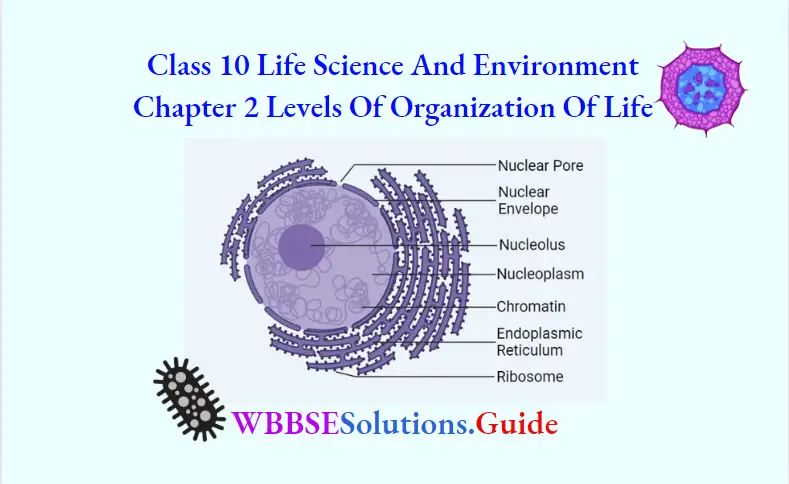
(1) Nuclear envelope :
Double cytoplasmic membrane with many ee pe membrane nuclear pores having definite ribosome organization. The two layers are ~ Diagrammatic structure of nucleus separated by Perinuclear space.
Functions :
(1) Transport and exchange of materials between nucleus and cytoplasm.
(2) It separates nucleoplasm from cytoplasm.
(3) Maintains definite shape of the nucleus.
(4) Ribosomes attached to the cuter face of the envelope are involved in protein synthesis.
(2) Nucleoplasm :
The transparent, jelly-like matrix within the nucleus is called a nucleoplasm. It is also called karyolymph. It fills the internal space of the nucleus. Consists of more than 90% protein. It stores food and enzymes.
(3) Nuclear Reticulum :
It consists of DNA and histone protein. Exists as a chromatin
network in the interphase nucleus. During cell division, it condenses into distinct Chromosomes. Chromosomes are formed of genes which carry the characters from one generation to the next.
(4) Nucleolus :
The spherical dense body inside the nucleus. It consists of granular
part, fibrilar part, matrix and chromatin body. It is usually formed by the aggregation of the Nucleolar Organizer Region (NOR) of the chromosomes.
Functions :
(1) Help in cell division.
(2) Production of ribosomes.
Question 15. Why is mitochondria called the powerhouse of a cell?
Answer:
Mitochondria :
Highly specialized double membrane-bound organelles are present in the cells of higher plants and animals. Kollicker (1850) first observed mitochondria. Altman (1892) called them bioplast. Benda (1897) proposed the name mitochondria. Hogeboom (1948) confirmed mitochondria as the seat of aerobic respiration. It is present only in Eukaryotic cells except in matured RBCs of mammals. The inner membrane is thrown into finger-like projections called cristae. The matrix contains enzymes for the TCA cycle reaction. Cristae is the site for terminal oxidation, ATP formation, utilization of oxygen and formation of water.
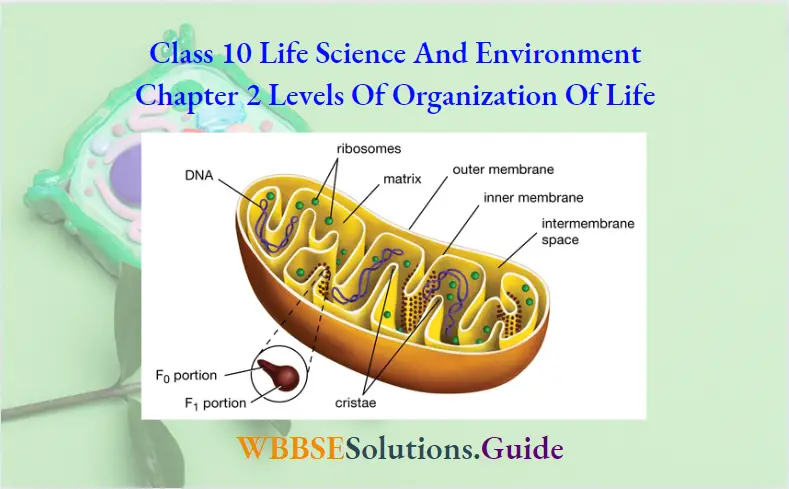
Functions :
(1) It is known as the powerhouse of a cell because it produces and stores energy in the form of ATP.
(2) It helps in the metabolism and the breaking of fat molecules.
(3) It also produces certain respiratory enzymes.
Question 16. Write the structure and function of the Endoplasmic Reticulum.
Answer:
Endoplasmic Reticulum :
It is a network of double membranes distributed all over the cytoplasm. The tubules or vesicles are interconnected. It connects the nuclear membrane with the plasma membrane. It exists in different forms like Cisternae, Tubular ER and Vesicular ER.
ER is of two types :
(1) Rough Endoplasmic Reticulum has ribosomes attached to its surface.
(2) Smooth endoplasmic reticulum (SER) when the walls of tubules are smooth without ribosomes.
Functions :
(1) Mechanical support
(2) Maintenance of osmotic pressure
(3) Exchange of materials
(4) Protein synthesis
(5) May help in the storage of certain components.
(6) They divide the cell into different components.
Question 17. Explain the structure and functions of the Golgi body.
Answer:
Golgi body :
They are single membrane-bound flattened sac-like structures, present in animal cells.
In plant cells, they remain scattered and are called dictyosomes. It is discovered by Camilo Golgi (1890).
They include flattened sac-like cisternae, small round vesicles and larger vacuoles. They contain various secretory enzymes.
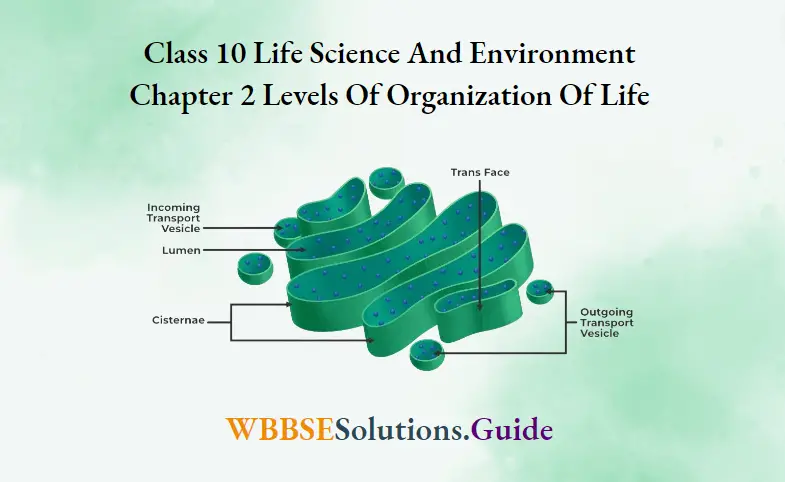
Function :
(1) Help in the secretory activities of the cell.
(2) They store protein and enzymes.
(3) They are from the acrosome of spermatozoa.
(4) Help in intercellular transport.
(5) It activates mitochondria.
Question 18. What are lysosomes and ribosomes? Write their functions.
Answer:
Lysosomes :
Their cell inclusions are characteristics of an animal’s cell. They have an outer membrane and their origin is from vesicles derived from the Golgi complex. Lysosomes contain hydrolytic enzymes. They -— Granular are abundant in WBC that bring phagocytosis ‘ Se of bacterial cells. Lysosomes are denoted by oe Cade Duve (1955). Lysosome performs four main functions:
(1) Extracellular digestion Structure of lysosomes
(2) Intracellular digestion
(3) Self digestion
(4) Digestion of substance outside the cell. They act as suicidal bags and help in the destruction of worn-out cells.
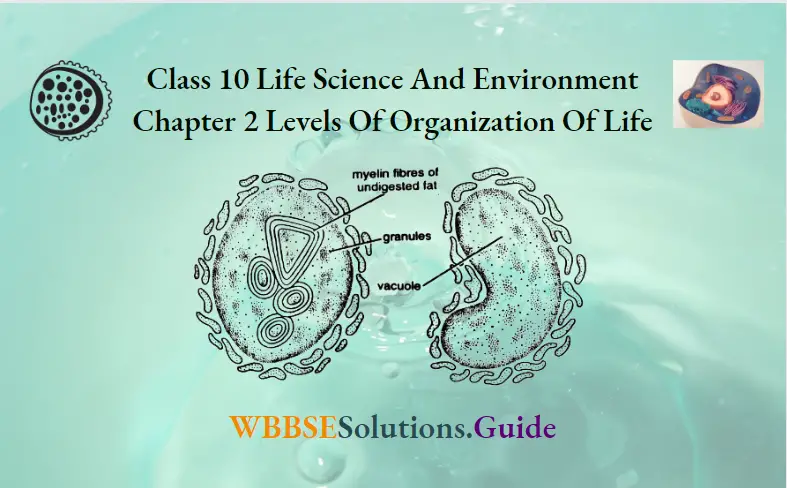
Ribosomes:
There are very minute spherical bodies found closely associated with ER. They contain ribosomal RNA and protein. They are formed from nucleolus and denoted by Robinson and Brown (1953) and Palade (1955). In prokaryotes, they are 70 s E Tanverse with two subunits 50S and 30S respectively, while depression in Eukaryotes, they are 80S with two subunits I Subunit (40S) 60S and 40S. (S for Swedberg unit). They remain in a chain called Polysome)
Function :
Synthesizing protein helps in lipid metabolism.
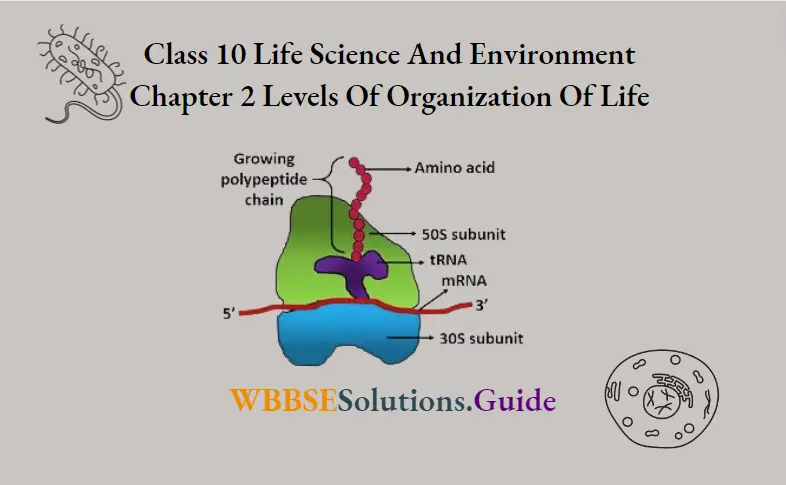
Vacuole :
There are empty spaces within Subunit protoplasms filled with cell sap or gases. More (605) common in plant cells. These may contain water, inorganic salt, organic material, etc.
It helps in osmoregulation by regulating the water content in the body. It also helps in the storage and digestion of food and excretion in unicellular organisms like Amoeba.
Question 19. What are centrosomes microsomes and microtubules? Write their functions.
Answer:
Centrosome :
The star-like organelle, very Centrosome close to the nucleus of an animal cell is called a centrosome. It consists of a pair of centrioles and the centrosphere surrounding it. Each centriole is cylindrical and open at both ends. The wall of each cylinder is made of 9 microtubules.
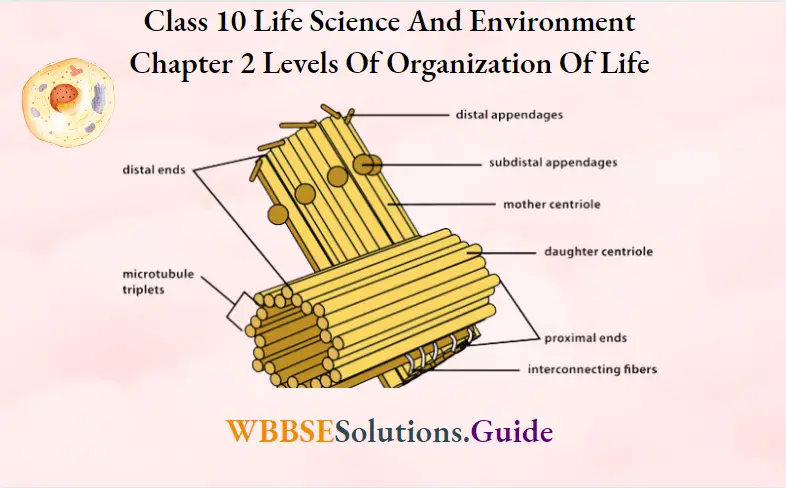
Functions of Centrioles :
(1) Give rise to basal bodies of cilia and flagella.
(2) Play an important role in cell division, forming spindle apparatus.
(3) It forms the tail of sperm in higher animals.
Microtubules :
Hollow unbranched tubules, made of sub-units of protein tubulin.
1. It provides polarity to cells.
2. Involved in cell movement.
3. Help in intracellular transport.
Question 20. What are plastids? Name and explain different types of plastids.
Answer:
Plastids :
Membrane-bound cell organelles are present only in plant cells. The term was denoted by Schimper (1883).
It is formed from a primitive plastid called Proplastid. It is of three types :
Chloroplast :
Green-coloured plastid containing green pigment chlorophyll. It is present in leaves and other green parts of the plants. They are formed of two distinct parts, the stack-like granum and ground substance stroma. Each granum is formed of an individual sac-like structure called a thylakoid. Each thylakoid is a membrane-bound flattened vesicle. Thlaokoid membrane contains photosynthetic pigment, electron carriers, and co-enzymes organised into Quantasome. It helps in trapping light energy and synthesis of ATP.
Functions :
(1) Site of all photosynthetic reactions.
(2) Responsible for conversion of light energy to chemical energy.
(3) Synthesis of Carbohydrate from CO2, and H2O.
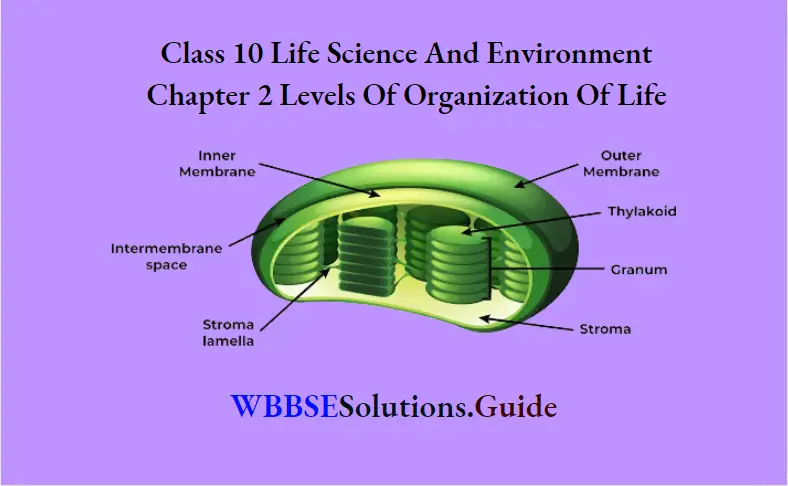
Chromoplasts :
Coloured plastids other than green are present in the flowers of plants. They contain carotene and xanthophyll.
Function :
(1) They help in insect pollination.
(2) They absorb the extra wavelength of the sun and help in photosynthesis.
Leucoplaslids :
Colourless plastids are remaining in the underground parts of the plants. It contains stored food and some enzymes. They are classified into three types based on the food they store.
Amyloplast (Storing carbohydrates), Aleuroplast (storing protein), and Elaioplast (storing fats).
Question 21. Differentiate between Prokaryotic and Eukaryotic.
Answer:
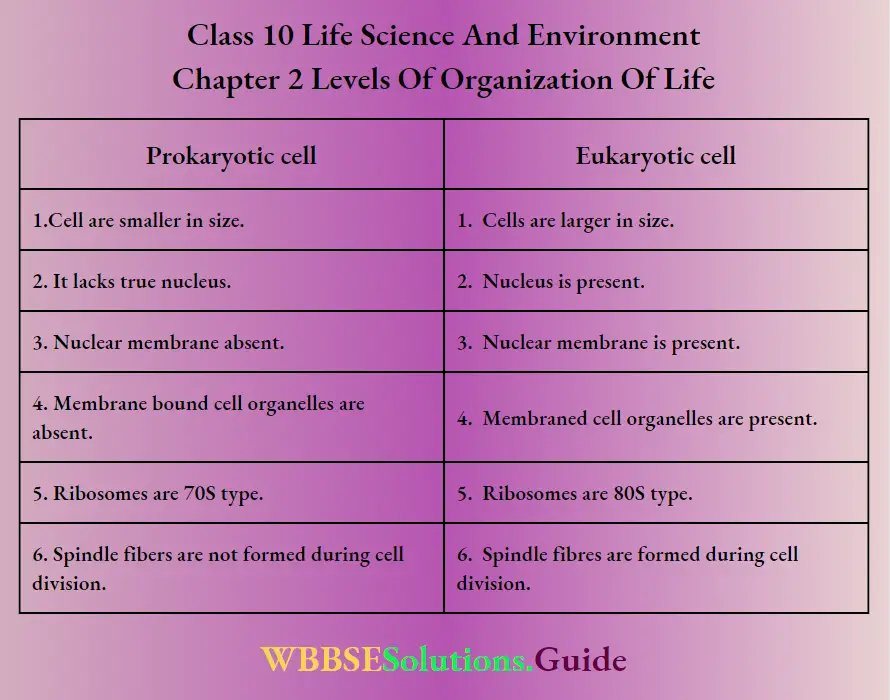
Question 22. Differences between plant cells and animal cells.
Answer:
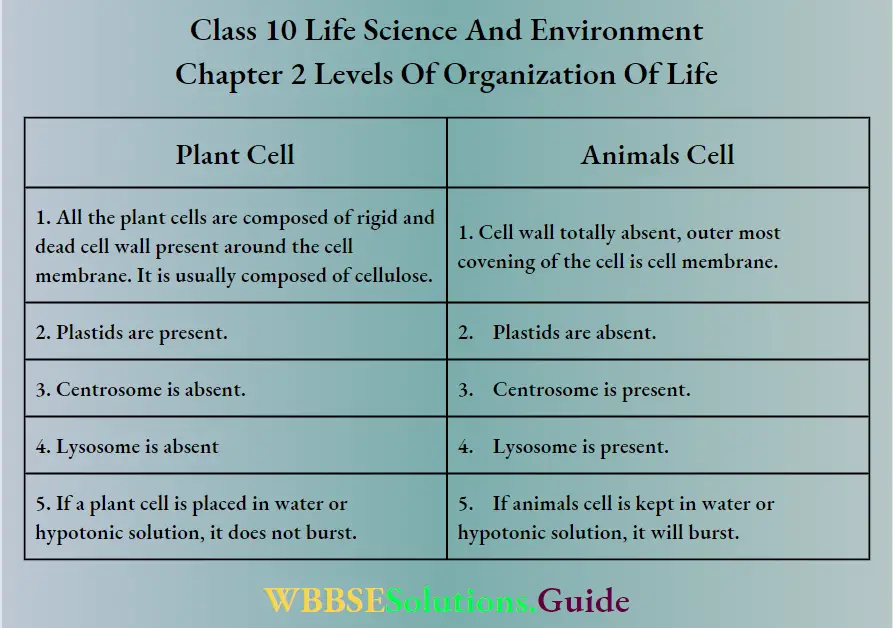
Question 23. What is epithelial tissue? Name the different types of epithelial tissue. Write their functions.
Answer:
Epithelial Tissue :
The cells lie close together and are held together by all junctions, with little or no extracellular material. This type has one free surface, the other surface rests on the basement membrane. The blood vessels are absent.
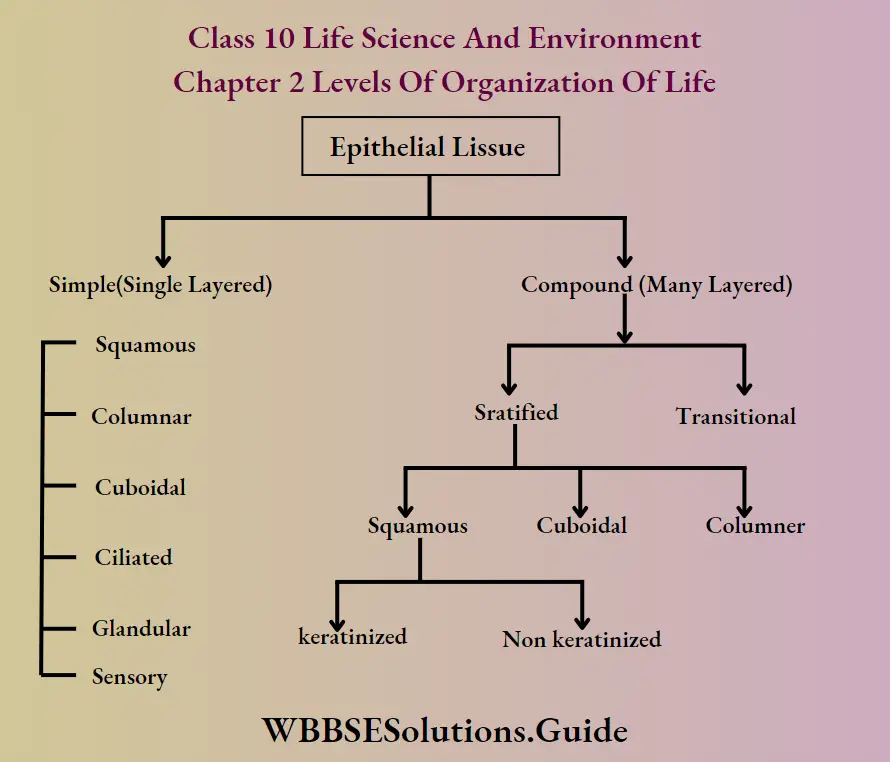
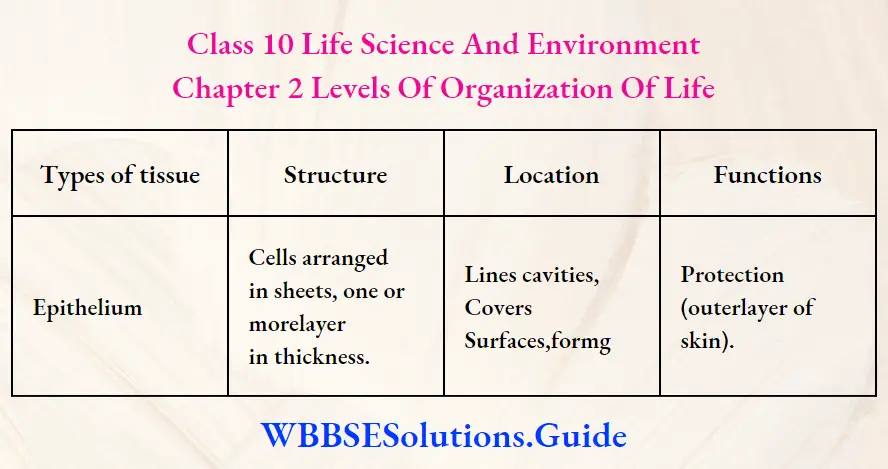
Question 24. Write the function and location of nervous tissue.
Answer:
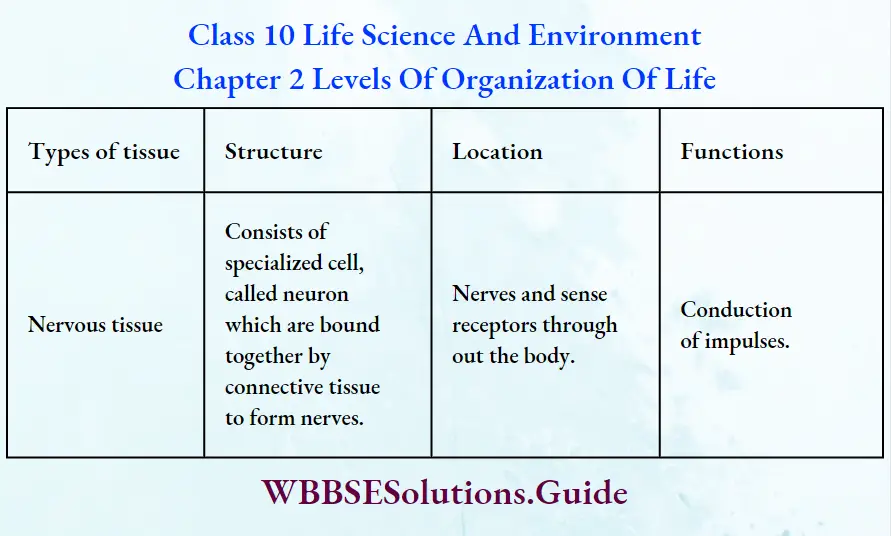
Question 25. What is muscular tissue? Name its types and functions.
Answer:
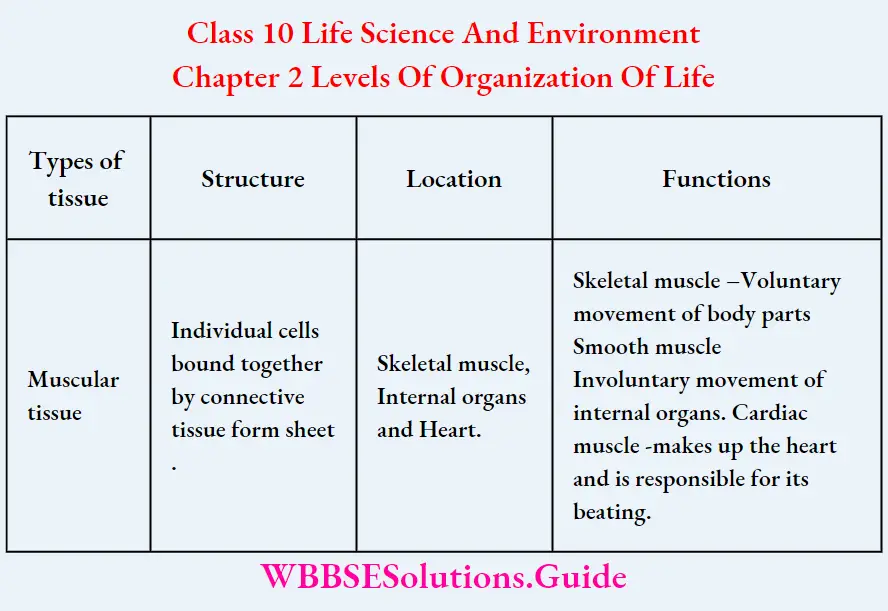
Question 26. Differences in bones and cartilage :
Answer:
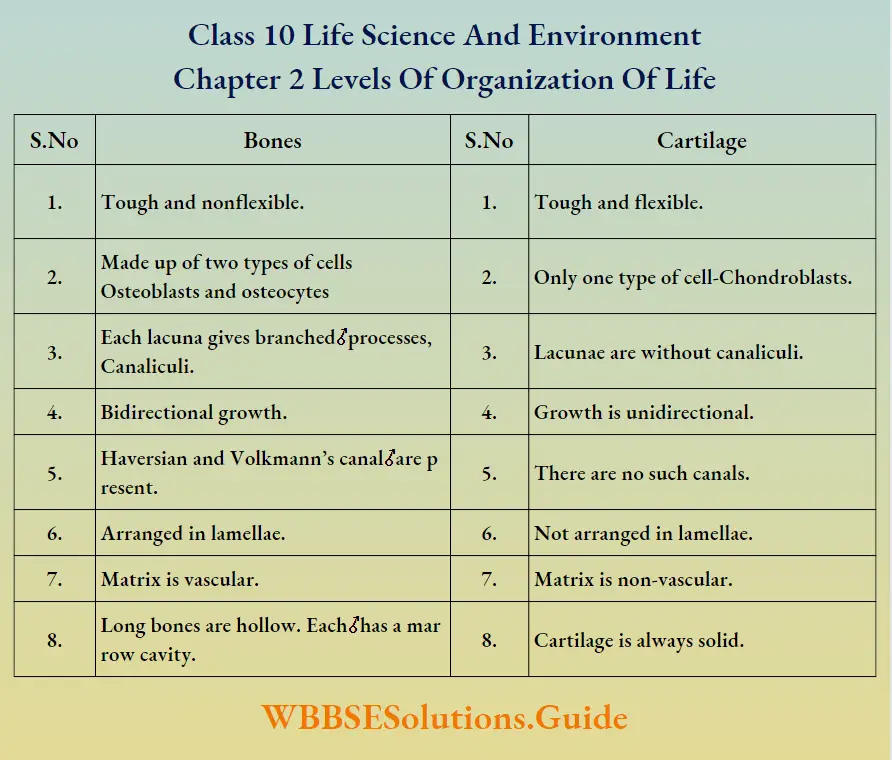
Question 27. What is connective tissue? State the location and function of different types of connective tissue.
Answer:
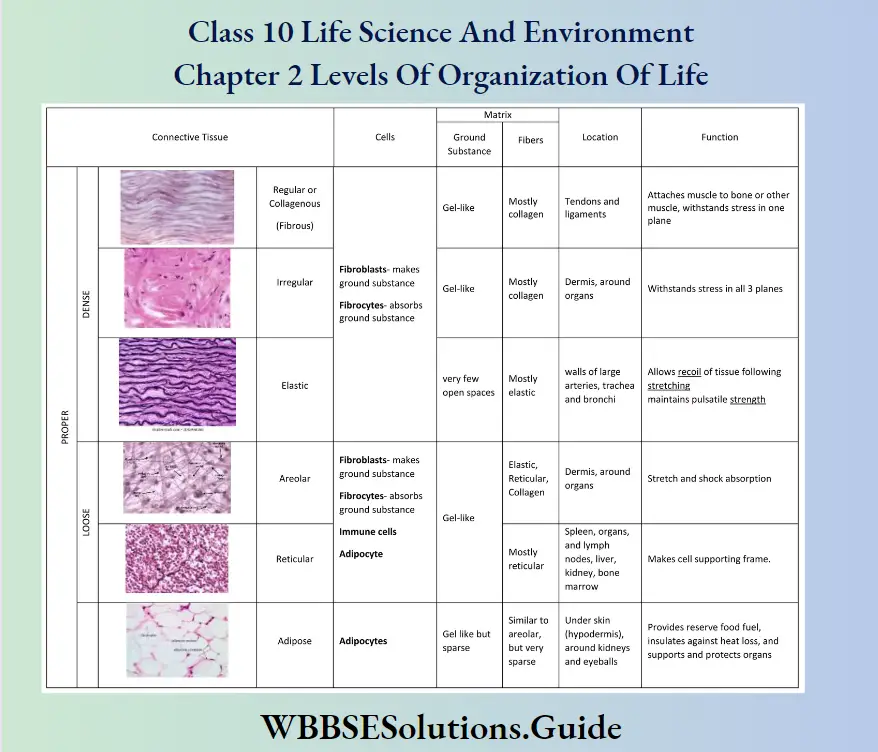
Question 28. Write the differences between blood and lymph.
Answer:
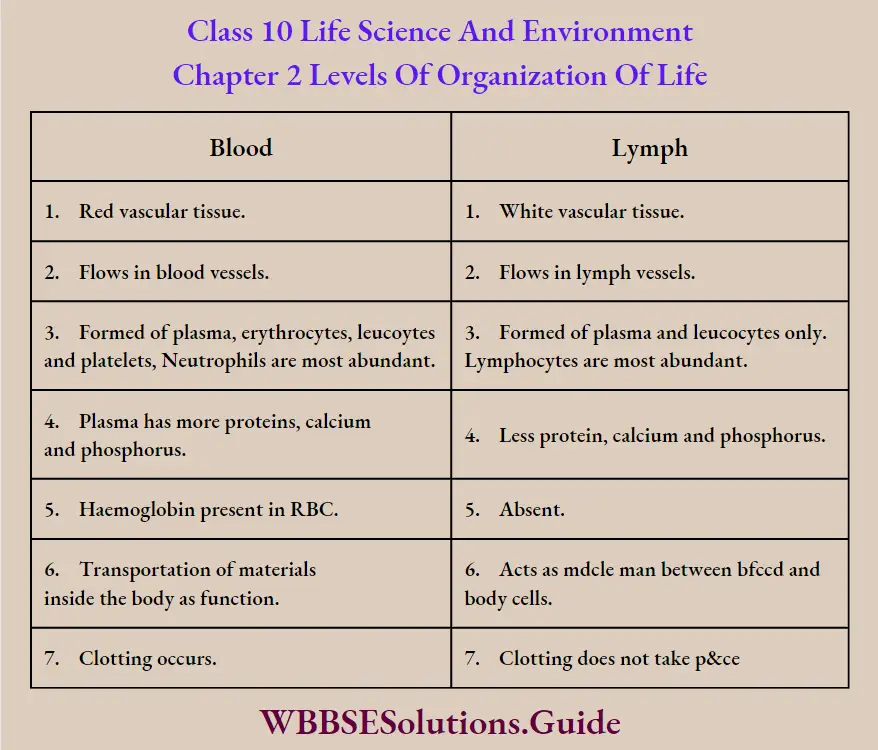
Question 29. Differentiate between striated and smooth muscle.
Answer:
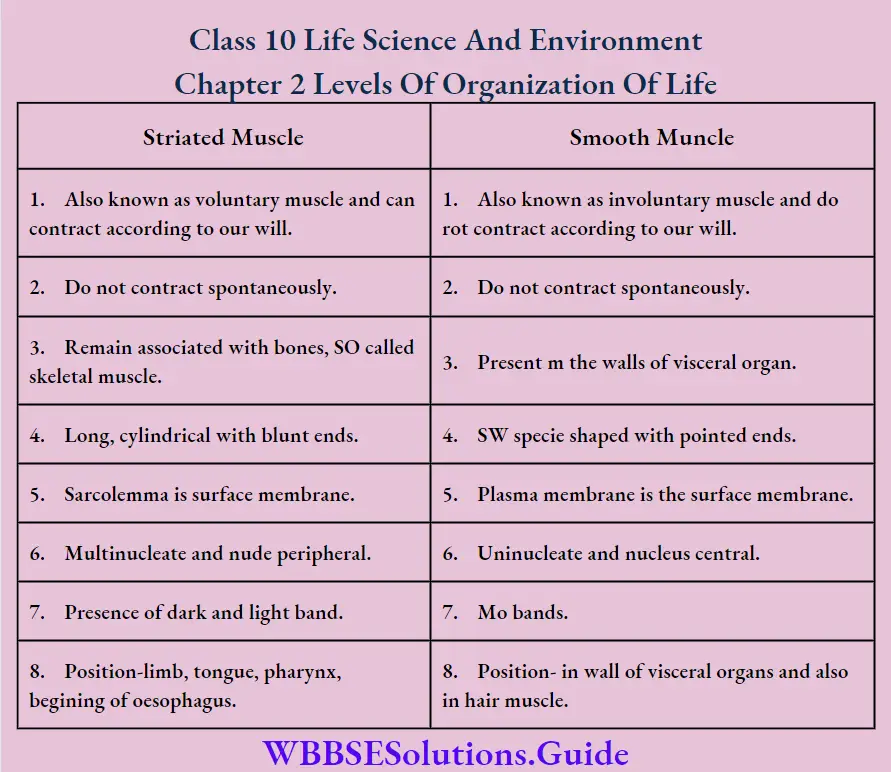
Question 30. Differentiate between Tendons and Ligaments.
Answer:
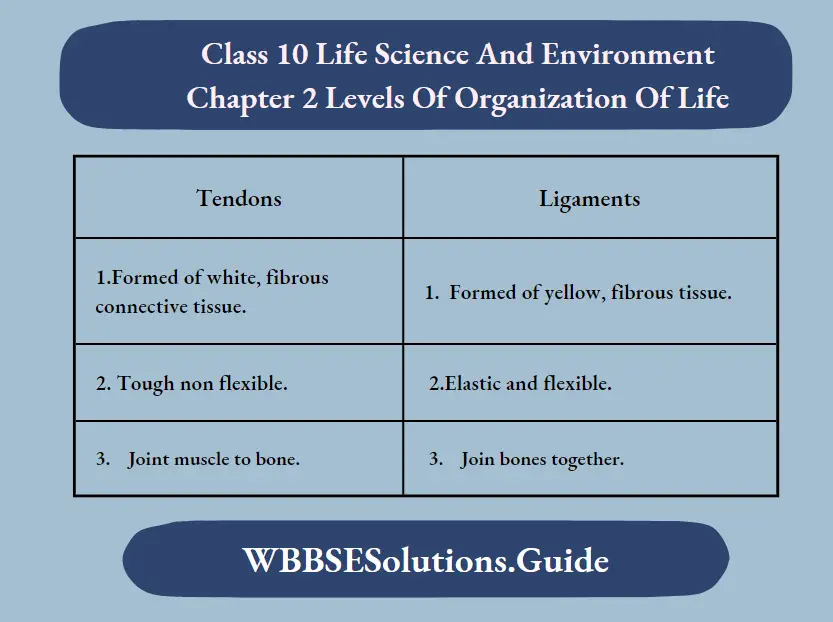
Question 31 What is a tissue?
Answer:
Tissue :
A tissue may be defined as a group of cells having common origin,similar structure and function being held together by a cementing substance.” The study of tissue is called histology.
In higher multicellular organism, however, although each cell can carry on all fundamental, vital, biological processes, it is not capable of independent existence. The cells of multicellular organism interact and cooperate with one another. For example, a muscle cell in man could not obtain food or oxygen on its own.
Cell —> Tissue -> Organ —> Organ system —> Individual
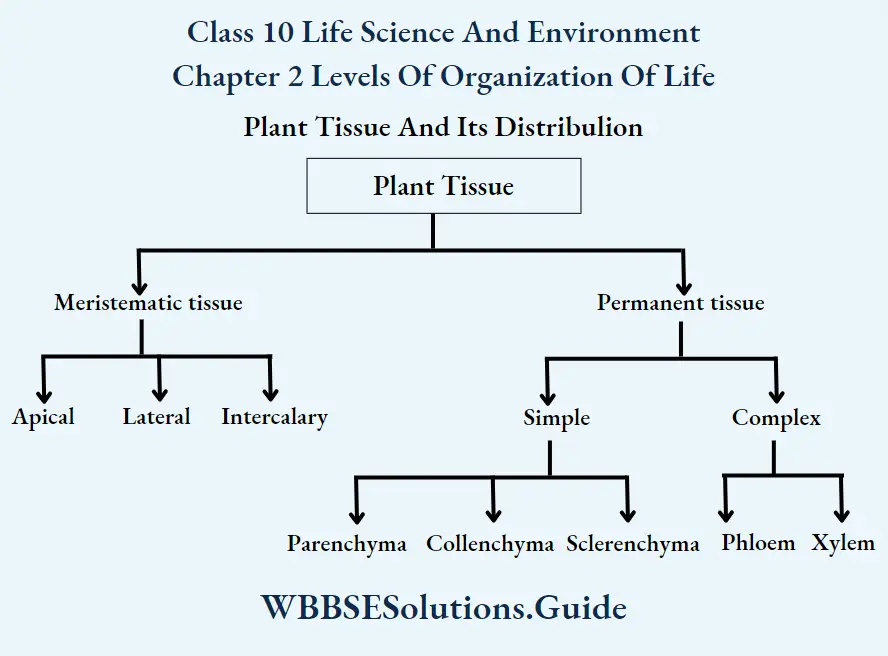
Question 32. What are Meristematic tissue ? Write its characteristics.
Answer:
Meristematic tissue :
It consists of a group of cells which have the capacity to divide. This tissue is found at all growing points of a plant such as tips of root, stem and branches. It is also present between the bark and the wood of trees where it leads to the growth in the diameter of stem.
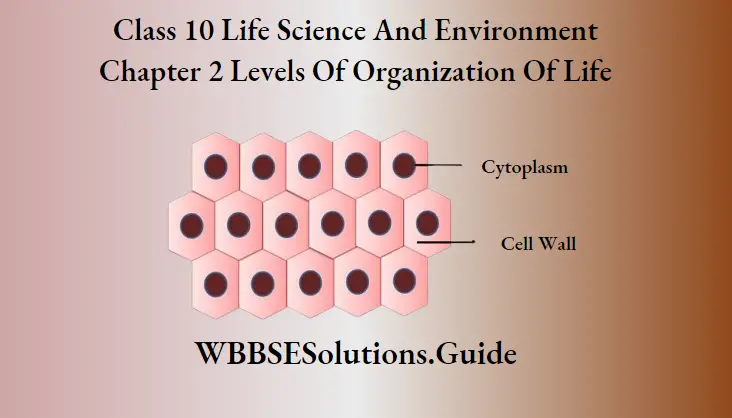
Characteristics :
1. Cells are small, usually cubical.
2. The cell walls are thin and large nucleus, densely cytoplasm.
3. Vacuoles are almost absent.
4. Cells are tightly packed with no intercellular spaces.
5. The cells actively divide, adding new cells to the plant.
6. New cells thus produced are transformed into mature permanent tissue.
According to location, meristems are :
1. Apical meristem — It is present at the apices of the root stem and other growing organs and helps in growth in length.
2. Lateral meristem — It is present in a circle parallel to epidermis of stem and root. It help in growth in diameter, e.g. cambium and Be cork cambium.
3. Intercalary meristem — It is present within permanent tissue in the internodal region of the stem. It helps in growth in length.
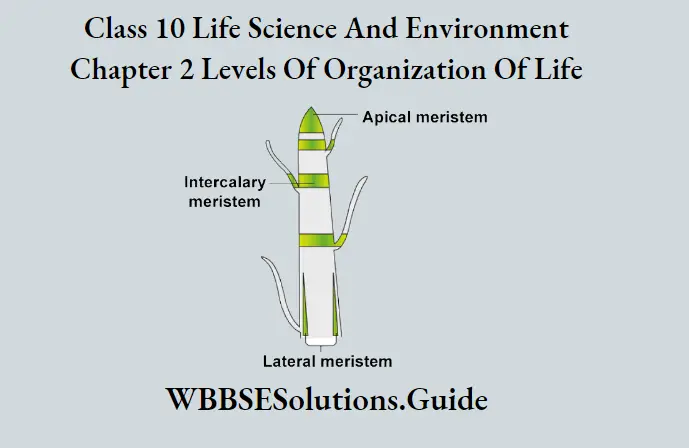
Question 33. What are permanent tissue? Describe with diagram its types and functions.
Answer:
Permanent Tissue :
Permanent tissue is made up of cells poses s’merstem. which have lost their ability to multiply. They take a permanent shape to perform some permanent functions. These may be simple or complex. These cells are either living or dead and thin walled or thick-walled.
Simple Permanent Tissue :
It is made up of one type of cells forming a uniform mass. On the basis of cell types, it is of three kinds :
(1) Parenchyma:
It is made up of living, usually isodiametric cells. The cell wall is thin and consists of cellulose, pectin and hemicellulose Intercellular eae usually runs between the cells.
Parenchyma are the ground tissue of a plant body. They are widely distributed throughout the plant body.
Functions :
(1) These cells mainly serve as packing tissue and constitute the bulk of the cortex, medullary rays, pith, xylem and phloem, fruit pulp and seed endosperm.
(2) It is storage tissue and store starch.
(3) Chloroplast containing parenchyma called chlorenchyma help in photosynthesis.
(4) Thick-walled parenchyma give mechanical support.
(5) Parenchyma containing air cavities called Arenchyma provide buoyancy to aquatic plants.
Collenchyma:
It is made up of parenchymatous cells which are elongated and are thick at the corner. It consists of living cells but is modified to provide mechanical support. There is extra deposition of cellulose at the corners of the cell.
This tissue is found in the leaf stalks and below the epidermis of the stem.
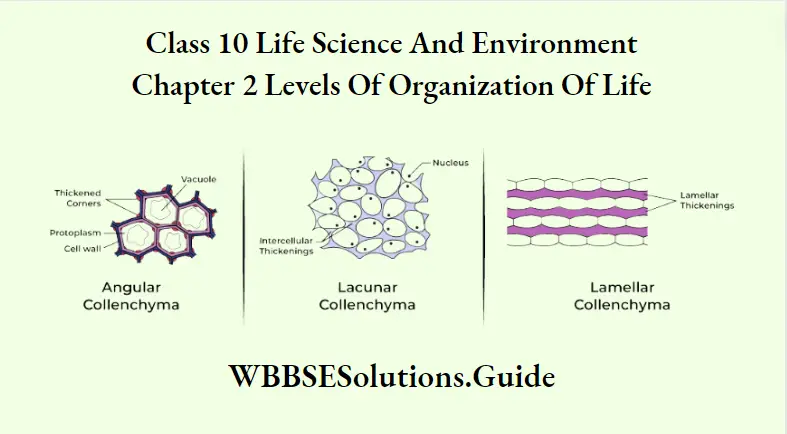
Functions :
It gives mechanical strength to the plant organs
Sclerenchyma :
The cells are dead with thick lignified cell wall. The cells are living when young but gradually loose protoplasm and die when fully formed. The cell wall is provided with cavities called pit.
It includes two types of cells fibre and sclereid or stone cells. Fibres are usually found in patches below the epidermis and endodermis, vascular bundle of leaf, stem and root.
Functions :
(1) Provide mechanical support.
(2) Stone cells provide rigidity to the plant.
Question 34. What are complex permanent tissues? Explain with a diagram the structure and functions of the xylem.
Answer:
Complex Permanent Tissue :
It is made up of more than one type of cell forming a mixed mass but working together as a unit. Two main types of complex tissue are the xylem and phloem.
Xylem :
Complex vascular tissue is concerned with the upward transport of water and minerals. It consists of four different types of cells, viz. Xylem fibres, xylem parenchyma, tracheids and vessels.
(1) Trachids are elongated tube-like, dead, single cells with perforation-lignified cell walls. Their end walls are tapered and overlap the adjacent tracheids. The cells have empty cavities called lumen. The walls have pit. Water can pass through the empty lumen.
(2) Vessels are long tube like structures formed by the SD fusion of several cells arranged end to end in a row. The long vessel helps in the transport of large amounts of water over long distancces.
(3) Xylem parenchyma – The cells are living, thin walled and abundant. These are mainly concerned with the short distance transport of substances and the storage of sugar, starch and lipid.
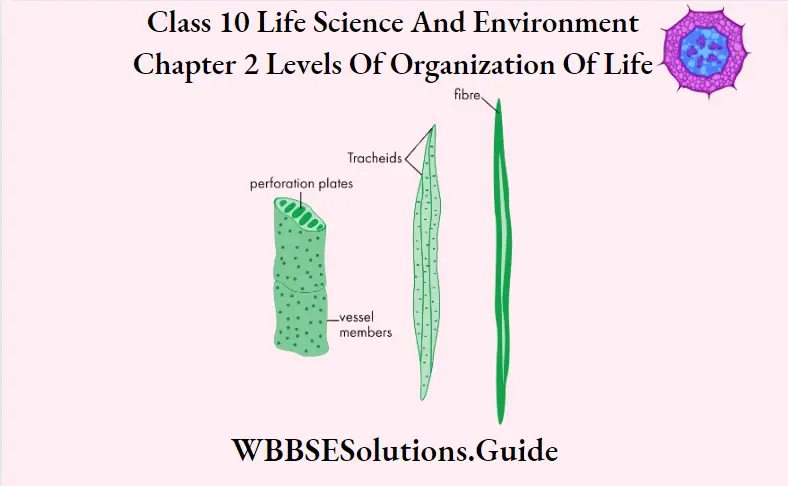
(4) Xylem fibre – Found mainly in woody plants. These do not conduct water and provide additional mechanical strength to the xylem.
Question 35. Name the different components of phloem. Write their functions.
Answer:
Phloem :
It possesses a tubular structure for the transport of food. The tube in the phloem is composed of living | PHLOEM – conducts be sounyard cells. It consists of four types of cells – phloem fibre, phloem-— parenchyma, Sieve tube and Companion cells.
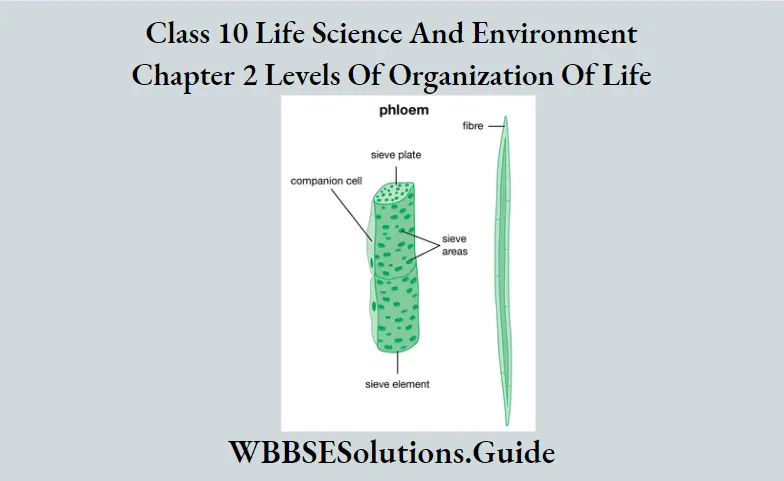
(1) Sieve tube are long tube like structure, involved in transport of organic solute like sucrose throughtout the plants. These are formed by end to end fusion of sieve tube elements.
(2) Companion cells – Thin walled elongated cells, is associated with each Sieve tube. Cells are living filled densely with cytoplasm and large nucleus.
(3) Phloem parenchyma – Mainly storstoresod materials. These are living and often cylindrical.
(4) Phloem fibre – Dead cell of phloem tissue, similar to sclrenchyma fibres. It provides mechanical support. Sclereids are more common in older phloem.
Question 36. Name the major organs in the human body. State their location and functions.
Answer:
Major Organs of Humathe and Body and their Functions:
Different tissues are usually grouped to form a larger functional unit called orgAnswer: In animals, organs together form even larger functional units called systems (for example, a digestive system consisting of the stomach, intestine, liver, pancreas, etc.)
Position Functions Skin Situated all over the body inProtection human. As excrtory organ, excrete sweat. As sense organ for touch, pain and temperature. Stomach J – shaped muscular bag in the abdomen to- wards the left and Gastric gland secretes gastric just below the diaphragm. Juice which consltsts hydrochloric acid, mucous and enzymes. HCI convirts pepsinogen into pepsin which help in digestion of protein. Pancreas It is a mixed gland located Secret pancreatic Juice which posterior to stomach consists of enzymes trypsin, amylase, lipase. Trypsin converts protein into poty peptides, amylase acts on starch and convirt them into maltose.
Question 37. What is the importance of water in life ?
Answer:
Importance or Functions of water :-
ife can not exist without water. It has versatile functions in the body and life processes:
(1) It is a universal solvent for all chemical and physiological reactions.
(2) Water maintains electrolyte balance and acid base balance of body fluids.
(3) It allows body’s cells to grow, reproduce and survive.
(4) It is the major component of different body parts.
(5) It acts as an important medium for osmosis, diffusion, filtration, transport and other physical processes.
(6) It helps to deliver O2, all over the body and transport of CO2,
(7) In digestion, it keeps the mucosal membrane moist; makes food digestible; dilutes food for enzyme action; synthesis of digestive juice; medium for digestion; and absorption of digested food.
(8) It provides media um for all metabolic reactions.
(9) It lubricates joints.
(10) It regulates body temperature by sweating and respiration.
(11) It helps in detoxification and elimination of excretory products.
(12) It acts as a shock k absorber for the brain and spinal cord.
(13) It is needed by the brain to manufacture hormones and neurotransmitters.
Question 38. What is the role of acids, bases and salts in the body of living organisms?
Answer:
Acids :
A hydrogen ion is a single free proton released from a hydrogen atom. Molecules containing hydrogen atoms that can rélease hydrogen ions in solutions are referred to as acids, e.g. HCL (Hydrochloric acid) ionizes in water to form hydrogen ions (H+) and chloride ions (CI–). Similarly, H2CO3, (Carbonic acid) ionizes in water to form H+ and HCO3–.
Some common inorganic acids in human body are—HCI in stomach, H2CO3 in blood, etc.
A base is an ion or a molecule that can accept W e.g. HCO3 – is a base because it can combine with W to form H2CO3. Similarly, HPO4–, is a base because it can accept an H* to form
H2PO4–.
In the human body, acid-base balance (buffer) is normally regulated by buffering agents— the respiratory system and the renal system. . .. Only six nonmetallic essential elements- carbon, hydrogen, nitrogen, oxygen,phosphorus and sulphur, make up most of the body weight (98%) of an organism. Various metals and nonmetals combine together to form different salts that are present in all living cells. :
Inorganic and organic salts of Ca, Mg, Na, K, and Fe, are very common in living cells.
Question 39. What is monosaccharide ? Write its structure, source and role in life processes.
Answer:
Monosaccharide :
They contain only one unit of simple sugar, e.g. Glucose, fructose, galactose, etc.
Basic Structural Features :
1. Colourless crystalline compounds, sweet in taste.
2. They undergo fermentation by yeast and other microorganisms.
Source :
Glucose (Dextrose) in grapes; Fructose (Laevulose)- fruit sugar which is present in almost all sweet fruits, honey; Galactose- it does not occur free in nature. In the body galactose is present as component of milk sugar (Lactose) which is formed of glucose and galactose.
Major Role in Life Processes :
1. Glycolysis – Glucose undergoes glycolysis to produce pyruvic acid in cell cytoplasm.
2. Storage — Excess glucose may be converted into starch in plants, glycogen in animals.
3. Maintenance of blood sugar — Normally 100 ml human blood contains 80-120 mg glucose.
Increase of this glucose level results into hyperglycemia (Diabetes mellitus) whereas decrease of glucose level is called hypoglycemia.
4. Synthesis of fats, pretend eins — By various metabolic reactions in life the r excess glucose may be converted to fatty acid, glycerol, amino acids, etc.
Question 40. Mention the basic features of amino acids. Discuss their role in life processes.
Answer:
Basic structural features :
1. Amino acid contains at least one central carbon (alpha) which is bound to a free amino group (—NH2), a carboxyl group (— COOH), one hydrogen (— H) and a side chain (R) which is different in each amino acid. Besides, all other three positions are fixed.
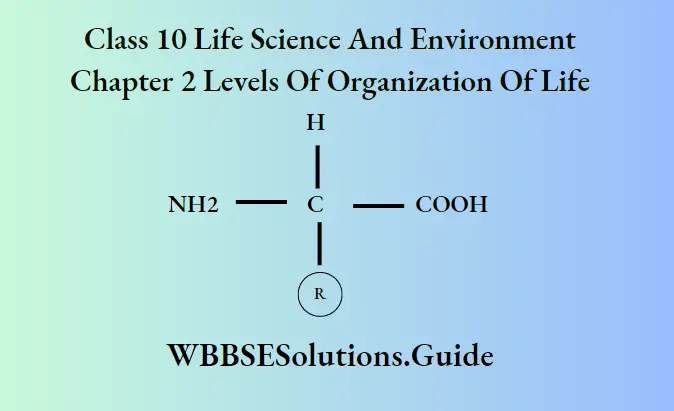
2. Amino acids are colourless, crystalline substances, solublein water.
Role in life processes :
1. Structure and Function of protein :
Since protein is made of different amino acids, so structure and function of protein depend on its component amino acids.
2. First class protein :
The protein that contains all essential amino acids and are capable of growth and maintenance, e.g. Albumin, globulin proteins of egg, meat, fish, milk, etc. (Almost all animal proteins are first class proteins).
3. Second class protein :
The protein contains a few essential amino acids but not all and is not suitable for growth and maintenance, e.g. Zein of Maize (most of the plant proteins are second class protproteins
Question 41. What is fatty acid? Mention its features, types and source.
Answer: Fatty acid is the essential component of fat.
Basic structural features :
1. Fatty acid has a carboxyl group (COOH) attached to it.
2. It is insoluble in water but soluble in fat solvents like chloroform, ether, alcohol, etc.
Types:
1. Saturated fatty acid, e.g. stearic acid, palmitic acid etc. .
2. Unsaturated fatty acid, e.g. Oleic acid, Crotonic acid.
3. Essential fatty acid—that are needed for normal growth but are not synthesized in the body—so they are taken along with diet, e.g. Linoleic acid, Linolenic acid and Arachidonic acid.
Source :
Stearic acids in animal fat; palmitic acid in paim ojl, milk, meat; butyric acid in milk, butter etc; oleic acid in olive oil, sunflower oil, animal fat etc.
Question 42. What is the role of fatty acid in life processes ? Distinguish between amino acid and fatty acid.
Answer:
Role in life processes :
1. They help in normal growth of the body.
2. They are structural components of cells.
3. They are responsible for normal reproductive functions.
4. They are necessary for healthy skin.
Difference between Amino acid and Fatty acid :
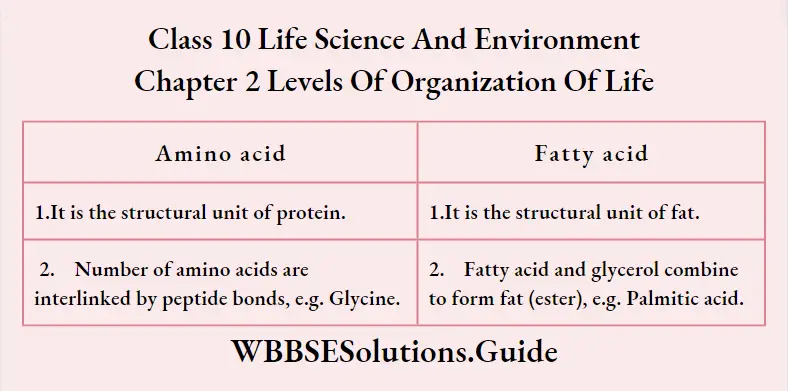
Question 43. Mention the structural features of nucleotides.
Answer:
Basic structural features :
1. One nucleotide consists of pentose sugar (5 — c- sugar}, Nitrogenous base (N-Base) and phoshoric acid (H3PO4).
2. N—Base can be of — Purine [Adenine (A) and Guanine (G)] and Pyrimidine [Thymine (T), Cytosine (C) and Uracil (U)].
3. A, T, Gand are present in DNA whereas A, U, G and C are present in RNA.
4. Nucleotide consists of pentose sugar and nitrogenous base without H3PO4.
Question 44. What are complex carbohydrates ? Classify them.
Answer:
Complex carbohydrates are oligosaccharides (disaccharides, trisaccharides, etc) and polysaccharides. They are formed of two or more monosaccharide units.
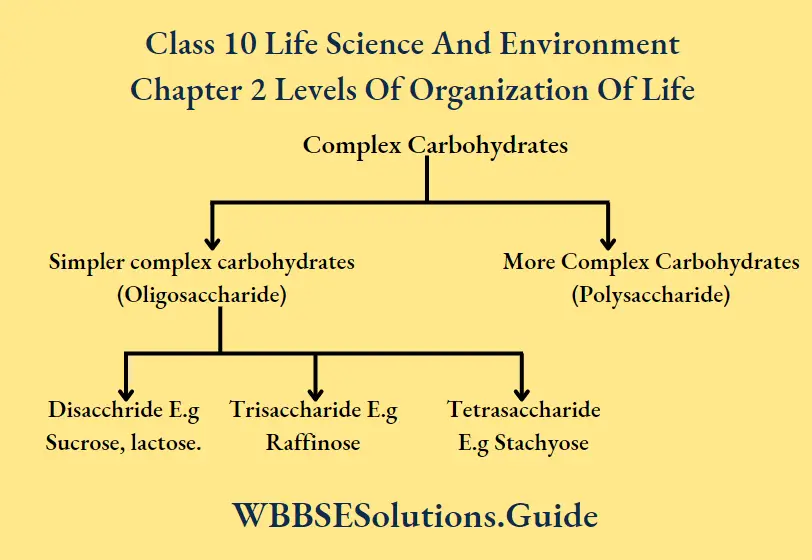
Simpler complex carbohydrates (Oligosaccharide) :
1. Disaccharides :
They are formed by the combination of two monosaccharide units with the elimination of one molecule water r.
e.g. Lactose (in milk) formed of glucose and galactose;
Sucrose (cane sugar) formis ed of glucose and fructose;
Maltose (malt sugar) form is the ed of glucose and glucose (i.e., two molecules of glucofose)
2. Trisaccharides :
They are formed by the union of three monosaccharide units. (Can you explain how many water molecules will be released in this structure ?)
e.g. Raffinose (found in beans, cabbage, broccoli etc) formed of glucose + fructose + galactose. :
3. Tetrasaccharides :
This is formed of four monosaccharide units. e.g. Stachyose (found in green beans, soya beans, etc.) formed of two molecules galactose + glucose + fructose.
More Complex Carbohydrates (Polysaccharide) :
Polysaccharides are polymers of large e number of monosaccharide units (monomer).
Polymer is the ‘garland’ whereas monomer is the ‘individual flower’ of the garland, e.g Glycogen is the polymer and each glucose unit is the monomer.
Basic Structural features :
1. They are commonly not seen.
2. Generally they are soluble in water (except cellulose).
Some common polysaccharides :
1. Starch — Polymer of glucose, produced by plants; insoluble in cold water; givegivee colour with iodine; tasteless.
2. Glycogen — Found in animals and fungi, known as ‘animal- starch’ soluble in water, gives a reddish colour with iodine.
3. Cellulose — Found in plants; insoluble in water; taken in the body along with vegetables; can not be digested in the human body.
Role in life processes :
1. Starch is the main constituent of food grains.
2. Glycogen is generally stored in the liver and muscle as a food reserve.
3. Cellulose forms ‘roughage’, stimulates peristalsis and helps in defaecation.
4. Carbohydrate (simple or complex) is the main source of energy when completely oxidised. One gram of ohydrate yields 4.0 Kcal energy.
Question 45. Mention the basic structural features of protein.
Answer:
Basic structural/ compositional features :
1. EsseThe essentialponent of protein is nitrogen.
2. The structural unit of protein is an amino acid.
3. Most of the proteins have a fishy smell.
4. When heated; protein coagulates
5. In acidic medium, protein is precipitated.
Question 46. What are enzymes? Mention their structural features and role in life processes.
Answer:
Enzyme :
Enzymes are biological catacatalystsotein in nature, produced by the
living cells, accelerate various biochemical reactions, but the selves remain undestroyed after the action.
Basic compositional features:
1. Nature — Almost all enzymes are proteins.
2. Structure — Like all other proteins, the enzyme is also formed of several amino acids.
3. Active site — We ingest food through our mouth, so mount the h is the ‘active site’ for ingestion. Similarly enzyme also performs its function by the ‘active site’ at a higher rate.
4. Specificity — Each enzyme acts on a specific substrate, e.g. Protease acts only on protein; lipase acts only on lipids, etc.
5. Catalytic property — Since enzymes act as biocatalysts, they are not destroyed at the end of the reaction.
6. Medium (pH) — Each enzyme acts in a definite medium, e.g. ptyalin in neutral = medium, pepsin in acidic medium, trypsin in alkaline medium and so on.
7. Temperature — Enzyme shows maximum activity in optimum temperature (GONG 40°C). At very high temptemperaturesove 40°C) enzyenzymes get damaged
(denaturation).
8. Action — Enzyme action is reversible and may be inhibited by a suitable inhibitor.
Role in life processes :
1. EnzyEnzymeselerate different biochemical reacreactions They are essential for any metabolic reaction in living organisms.
3. They play a very significant role in digestion.
Question 47. Discuss the role of lipids in life processes.
Answer:
Role in life processes:
1. Calorific value :
Lipid provides a food with high calorific value. One gram of lipid produces about 9.3 Kcal energy.+
2. Storage :
Lipid acts as reserve food material because it can be easily stored in the body for future use.
3. Reaction :
The storage (depot) fat protects the vital organs, skin, etc, and also acts as cushion and packing tissues.
4. Heat insulations :
Lipid acts as insulin later. Thus subesubcutaneous helps to regulate body temperature (thermoregulation).
5. Solvents :
Lipid is a good solvent for fat-soluble fat-solubleamins like Vit. Ay DP ERK
6. Hormone synthesis :
From cholesterol, all steroid hormones are synthesized in animals.
Question 48. Discuss the structural features of DNA and RNA.
Answer:
The structural features of DNA and RNA
DNA (Deoxyribose Nucleic Acid)
It is usually double-stranded or double-helical.
Two complementary chains are named as (alpha) and (Beta)
Two chains are antiparallel and interlinked by H-bonds. The structural unit of DNA is called deoxyribonucleotide which consists of pentose (deoxy-ribose) sugar, H3PO4 and N-Base.
N-Base can be of two types — purine and pyrimidine.
Purine of DNA is again of two types — Adenine (A) and Guanine (G), whereas pyrimidine is again of two types — Thymine (1) and Cytosine (C)
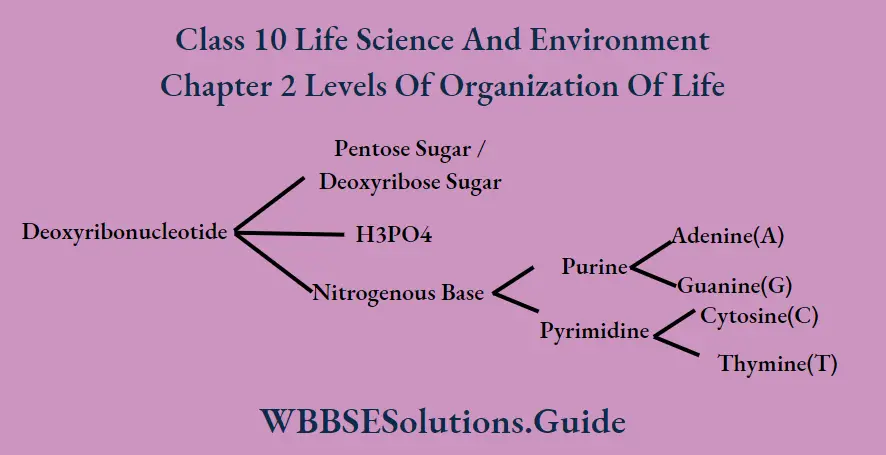
RNA (Ribo Nucleic Acid) :
1. It is generally single-stranded or single-helical.
2. The structural unit of RNA is ribonucleotide which consists of pentose sugar (ribose), H3PO4 and N-Base.
3. N-Base can be of two types — Purine and Pyrimidine.
4. Purine in RNA is of two types — Adenine (A) and Guanine (G) whereas pyrimidine is again of two types-Uracil (U) and Cytosine (C).
Question 49. Distinguish between DNA and RNA.
Answer:
Difference between DNA and RNA:
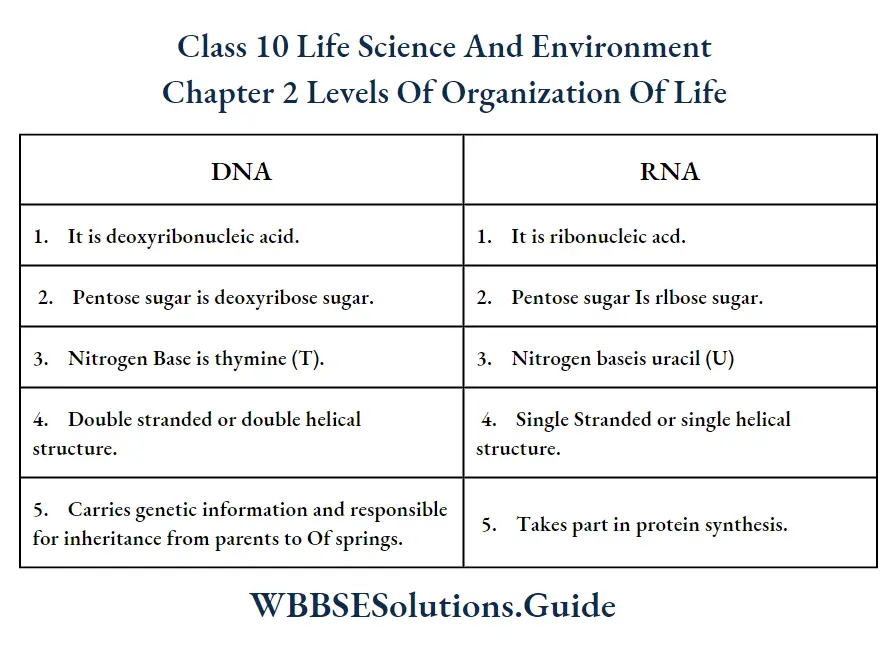
Question 50. Discuss the role of DNA and RNA in life processes.
Answer:
DNA:
(1) It contains genes and is responsible for the range of characteristics from parents to off offspring) It is responsible for all characteristics of an organism.
(3) Tt controls cell division where a mother cell divides itself to produce two daughter cells.
RNA:
(1) In plant viruses like TMV (Tobacco Mosaic Virus) and some animal viruses like Influenza virus, HIV, etc. RNA contains genes- so RNA is the genetic material in them.
(2) MRNA (Messenger RNA) carries information from DNA and helps in protein synthesis.
(3) tRNA (Transfer RNA) collects amino acids from cell the cytoplasm protein synthesis.
(4) rRNA (Ribosomal RNA) is the structural component of riboribosomes that helps in protein synthesis.
Question 51. Discuss the role of ATP as the energy currency of cell cells:
Role of ATP as Energy Currency of a cell :
ATP (Adenosine Tri Phosphate) is the primary molecule for storing and transferring energy in cells. It is often referred to as “energy currency of the cell” and may be compared to storing money (ATP) is a bank (cell). In any energy-related chemical reaction of the cell, ATP is either produced or consumed. For example, during photosynthesis, ATP is synthesized by photophosphorylation) using solar energy, whereas during respiration, ATP is synthesized through glycolysis, the Krebs cycle, and ETCC. The production of ATP in ETC is known as oxidative phosphorylation.
ATP is a nucleotide consisting of a N-Base [Adenine (A)], attached to a ribose pentose sugar (s-c-sugar), which is attached to three phosphate groups, that are linked to one another by two high-energy bonds.
ATP: Adenosine – P ~ P ~ P (N- Base)
The symbol ~ designates a high energy. So; in 1 ATP, there are 2 high energy bonds. When these high-energy bonds are broken, energy is released, which is utilized for any biochemical reaction of the cell or body.
ATP = ADP + Pi + energy
ATP = AMP + PPi + energy
Question 52. What are the characteristics of vitamins ?
Answer:
General characteristics of vitamins :
1. Vitamins are obtained from plant products and animal products.
2 . The daily requirement of vitamins is very low.
3. A small amount of fat-soluble vitamins may be stored in the liver and vitamin C in the adrenal cortex.
4. Vitamins are destroyed after reaction hence they must be supplied to the body regularly.
5. Some of the vitamins are heat stable (e.g. vitamin A, D, E, K, B, etc) but some of the vitamins are heat labile (e.g. vitamin B1, B3, vitamin C, etc).
Question 53. What is a micra tubule? Mention its structure and functions:
(1) Microtubule:
In the cytoplasm of eukaryotic cells are numerous non-membranous hollow cylinders known as micrmicrotubules) Structure :
Microtubules have variable length. They are formed of a special type
of protein called tubulin. Each tubulin consists of two sub-units (dimer) — @ and f.
(3) Functions :
(1) They from a supporting framework or cytoskeleton and give
shape to the cell.
(2) Microtubules form spindle during mitomitotic/meiotic division. (3)They form cilia and flagella that help in movement.
Question 54. Distinguish between — (a) Parenchyma and Collenchyma, and (b) Collenchyma and Sclerenchyma.
Answer:
Difference between Parenchyma and Collenchyma :
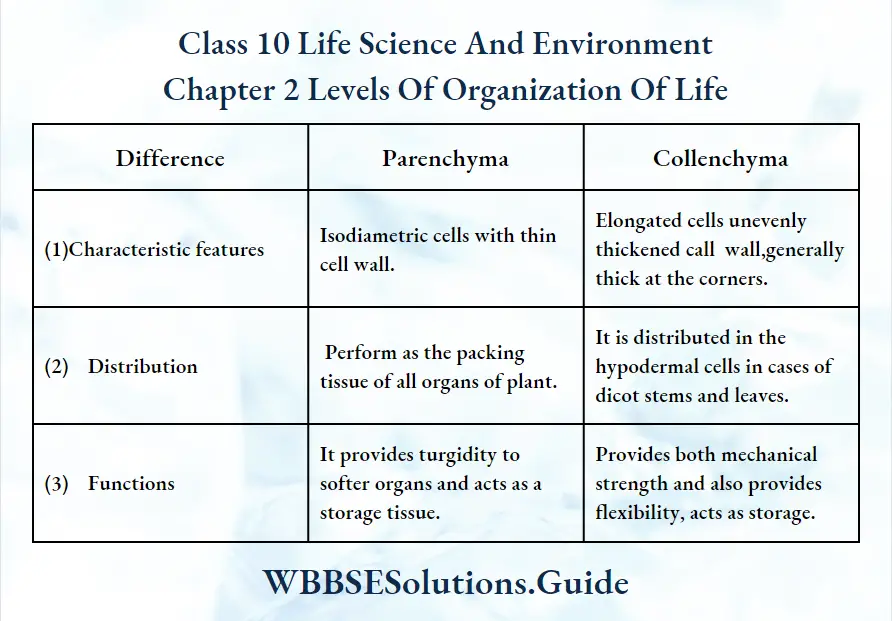
Difference between Collenchyma and Sclerenchyma:
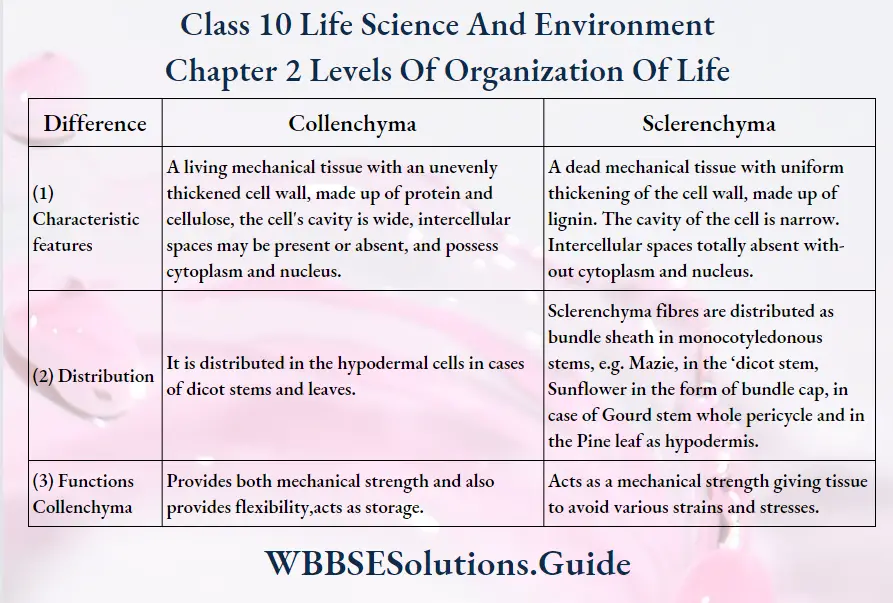
Question 55. Distinguish between xylem and phloem.
Answer:
Difference between Xylem and Phloem:
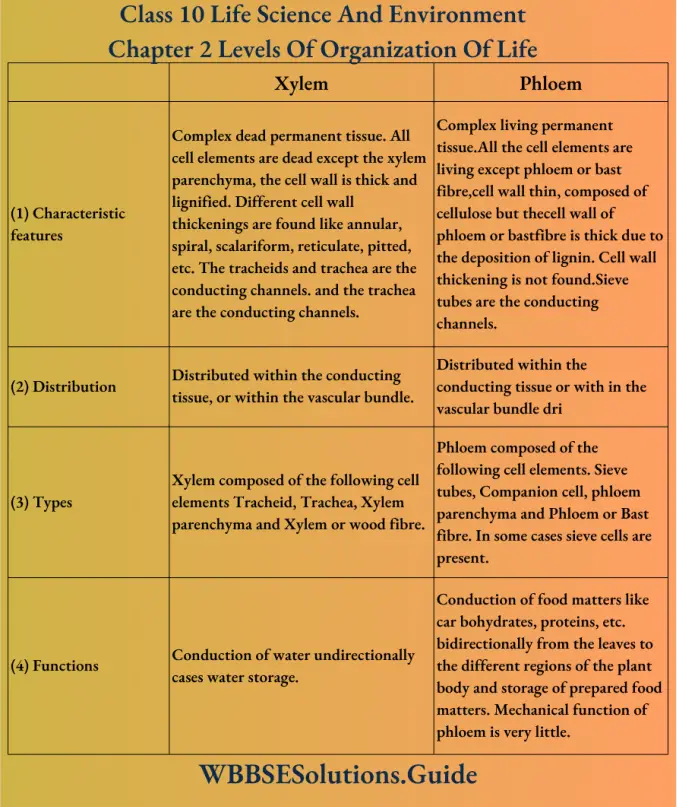
Question 56. Make a comparison of parenchyma, Collenchyma and Sclerenchyma.
Answer:
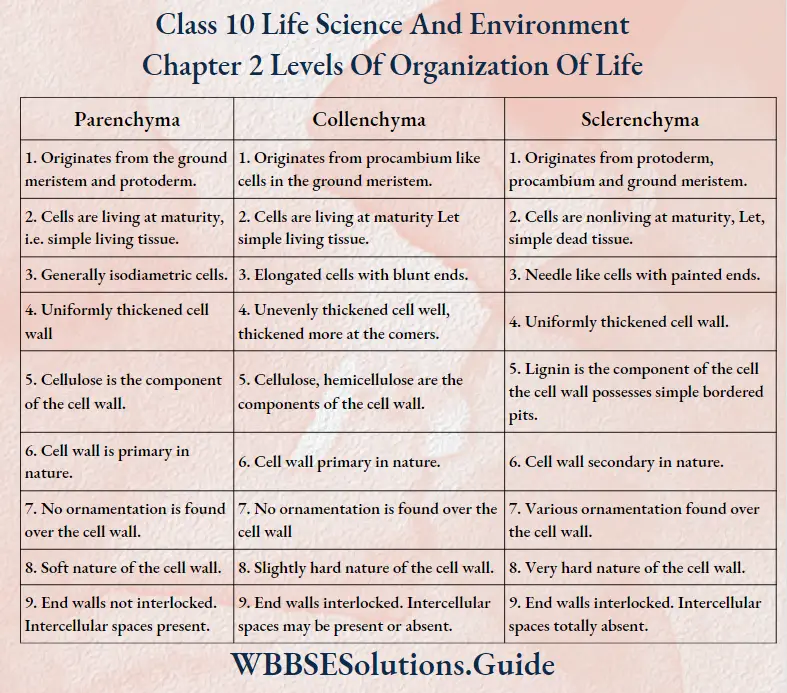
Question 57. What is stratified epithelium? Classify it.
Answer: Stratified epithelium or stratified epithelial tissue is composed of many layers of cells. Depending on the shape of the constituting cells and structural arrangements this variety of tissue is sub-divided into the following types
(1) Stratified squamous cornified-found in the skin and helps to protect from injury;
(2) Stratified squamous non-cornified- found in the cornea, mouth, pharynx, etc. and helps to afford mechanical protection;
(3) Stratified cubical- found in the pharynx, epiglottis, etc. (iv) Stratified columnar ciliated- found in the oft palate, some parts of larythe nx, etc.
